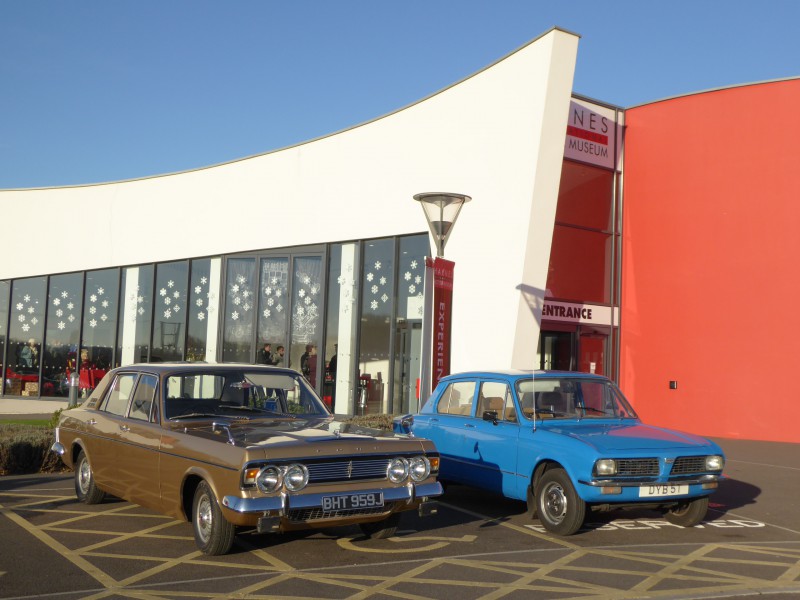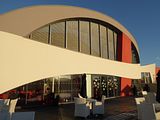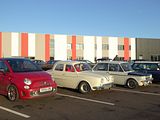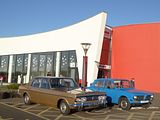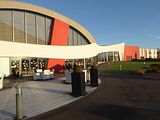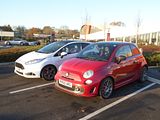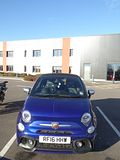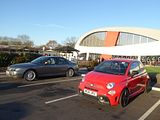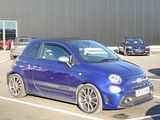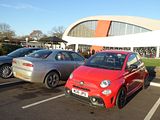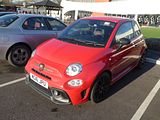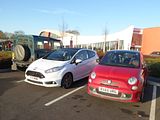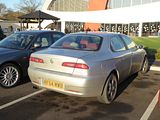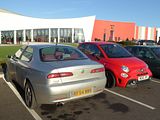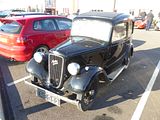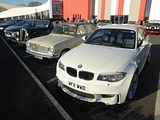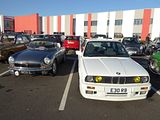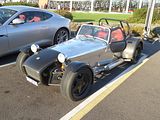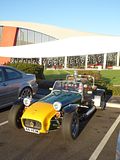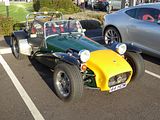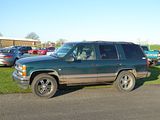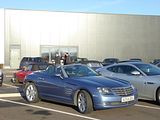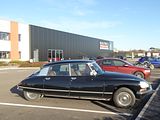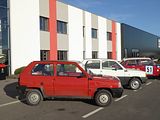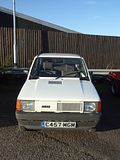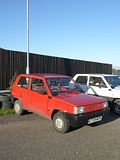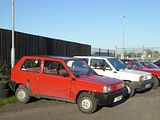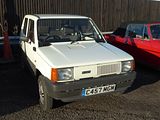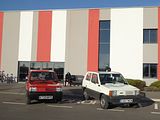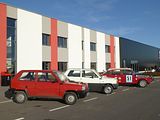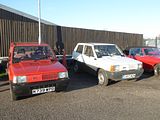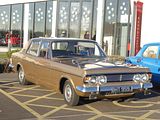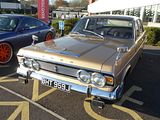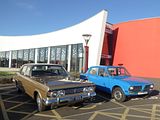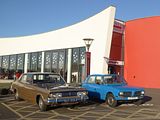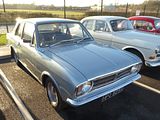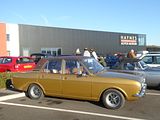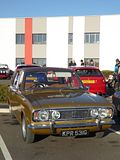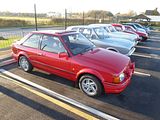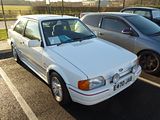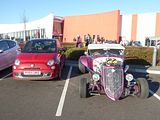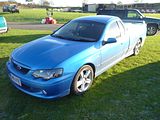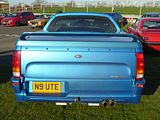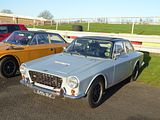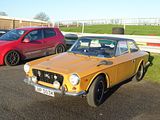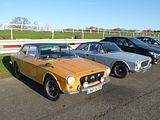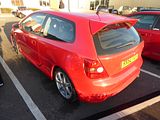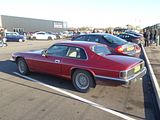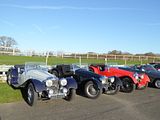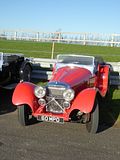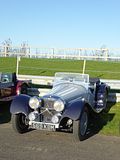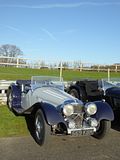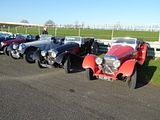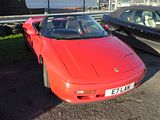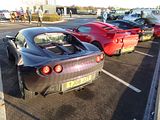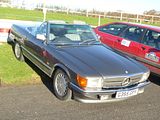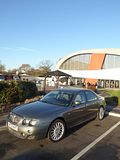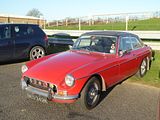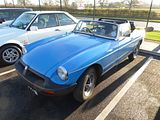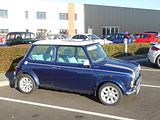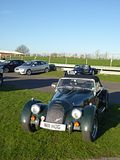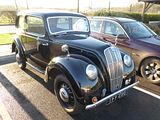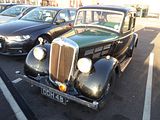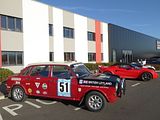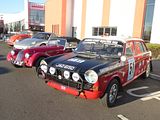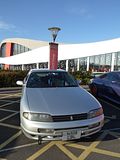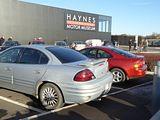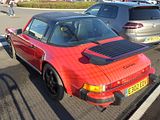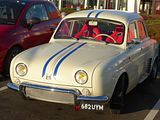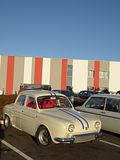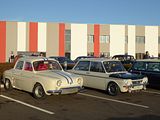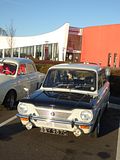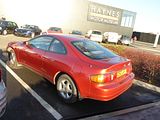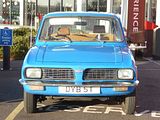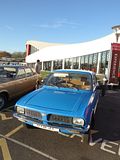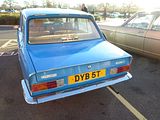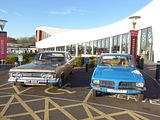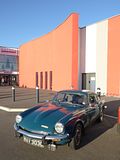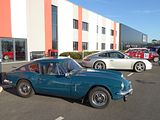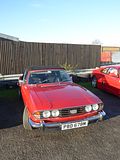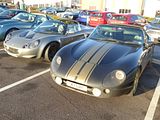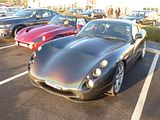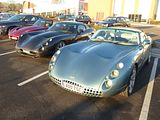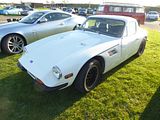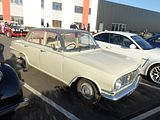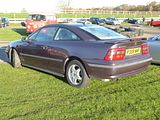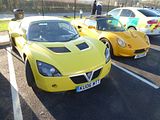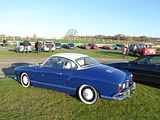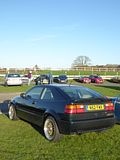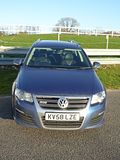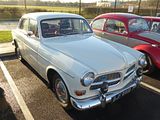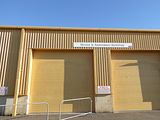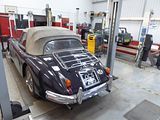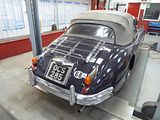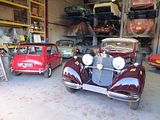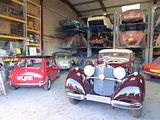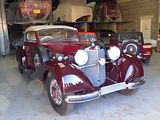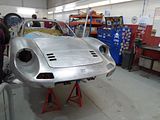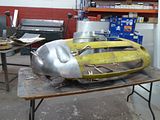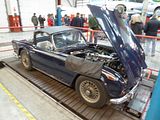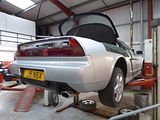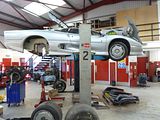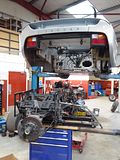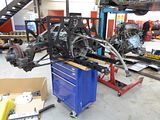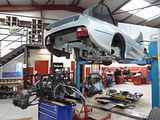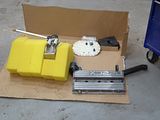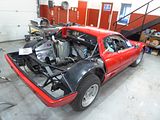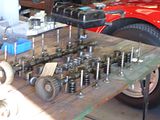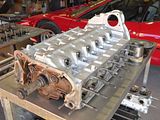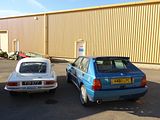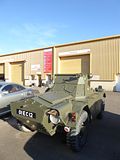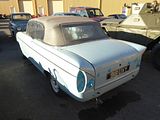With such a vast number of car-related events taking place almost every weekend of the year, it’s impossible to attend everything that you would like to. Almost inevitably, those which run on a regular basis, such as the popular “Breakfast Clubs” or “Cars and Coffee” meets, unless they have a very particular theme, get in my diary planning a somewhat lower priority than those events which take place just once a year. Come the winter months, there is rather less going on, so it is perhaps no surprise when I realise that the last time I ventured down to the Haynes Museum, in rural Somerset, just off the A303, near Sparkford for its monthly Breakfast Club was some months ago, in the last “low season”. That particular morning, back in March 2016, showed how from tentative beginnings of this event, early in 2015, word had gone around, and the gathering was packed by 8:30 in the morning. So when the forecast of a sunny, but bitterly cold Sunday in December turned out to be a reality, I set off in a clean car to see who else would choose to brave the weather. By the time I arrived, the car was less than clean, sadly, though it does a better job of hiding it than some colours would do, and the area in front of the museum was filling up nicely. It was not long before cars were being directed to the overflow parking area around the side, meaning that there was plenty to look at. Here are some of the highlights:
ABARTH
In the end there were three Abarths present. Mine was the first on site, but I had not been there very long whenever the next arrived, a Series 4 car in the latest shade of red. Not recognising the occupants, or the plate, I wandered over to introduce myself, and found out that this was in fact a dealer presence, from Vale Motors in Wincanton. I had quite a chat with them, explaining my role as Abarth Owners Club Events Manager. They’ve been selling the brand for a year now, along with Fiat and Suzuki and are keen to do more with the owners community. Later in the morning I noted that a third car had arrived, another 595, in the very popular Podium Blue colour.
ALFA ROMEO
Sole Alfa Romeo present was this 156 JTD in the later facelift guise.
AUSTIN
The Austin Seven was produced from 1922 until the outbreak of war in 1939, during which time a vast array of different versions were produced.
BMW
Three M model BMWs attracted my camera, though there were a few regular contemporary cars parked up among the rest of the display as well. One of them, the 1 Series M, is strictly speaking not an M car, though this is a rather pedantic distinction, as in all important respects, such as the way it drives, and looks, it hits all the same spots as the real deal. With only 450 of them sold in the UK, making it hard to find one for sale now, this car has lost little value, and is a certain classic of the future. Joining it were a couple of M3 cars, an E46 and an earlier E30.
CATERHAM
There were a couple of Caterham models here. Kudos to the owners for bringing them, and they were parked up early, as it would not have been a warm experience, especially early in the morning until the sun got up a bit. Both were relatively recent models from the over 40 year history of the marque, a story of continual development, a four decade process of honing Colin Chapman’s original design, which is now 60 years old. Since 1973, when Graham Nearn’s Caterham cars took over the rights and manufacture of the fly-weight sportscars, it’s grown more power, better engines, more sophistication in both suspension and powertrains, as well – in some cases – as more space inside and certainly more creature comforts, all while preserving the original character. Caterham completed 42 of the heavier and not that well thought of Series 4 cars before deciding to concentrate on the classic Series 3 design, with a simple space frame chassis clothed in aluminium and glassfibre. At the time of the S3, the power unit was from Ford, with the Crossflow unit developing 84 bhp in GT form with a twin choke carburettor, though twin Webers were never far away. Sevens had started out with Ford side valve power, before the 948cc BMC A Series unit found its way into the car, followed by Ford’s new 1340cc and 1498cc engines, before the head redesign put the intake and the exhaust on opposite sides. When Ford discontinued the Kent engine in 1976, it caused something of a difficulty for Caterham, as this also meant the end of the Twin Cam and the BDR engines, of which Caterham had bought 500 in preceding years, and whilst the final pushrod engines came from South Africa, eventually the supply ran out and a new supplier was needed. At first the firm turned to Vauxhall’s 2 litre unit for the higher powered cars but when the found out that Rover were developing a new and sophisticated twin cam engine, which turned out to be the K Series unit, a deal was struck and the first K Series engined Caterhams appeared in 1991, once the multi-point injection version was available (the single point would have required a bonnet bulge which Caterham did not want). To get round the relative lack of torque, Caterham developed their own close ratio 6 speed gearbox which was lighter than the Ford unit they had been using, and which could cope with larger capacity and more powerful K Series units as Rover made them available. Caterham continued to develop the car throughout the 190s, starting to make their own steering racks among other changes. By the time the K Series and the 240 bhp Vauxhall engines in the HPC car came along, the interior had become plusher with a long cockpit option and a wider variant, the SV. There were now proper bucket seats instead of those with a plywood backrest and in 1996 the handbrake moved from under the dash to the transmission tunnel. This required extra tubing in the chassis, which made it 80% stiffer. The front suspension had gained a proper top wishbone and separate anti-roll bar, but the biggest change came with the adoption of de Dion rear suspension. The move was occasioned by a need to keep the rear wheels linked and parallel to each other, yet still as simple as possible, though the engineers harboured a desire for a fully independent rear end, which finally came about with the CSR version in 2004. This change improved the ride massively on bumpy roads and makes the car feel more planted. The collapse of Rover in 2005 meant the end for the K Series, so there was a switch back to Ford power, using the Sigma engine, which happily fits under the bonnet – something that few modern engines do as they are now often simply too tall. Adding more power is a law of diminishing returns with a Caterham, thanks to the aerodynamics, though there are now an array of different power outputs offered, but the most recent change was a new entry level model, which uses a 660cc Suzuki turbo triple, with a live axle and a similar power to weight ratio to the classic single carb Ford powered models of 30 years ago. However, these days you can get carpets, leather seats and full weather gear if you upgrade to an S pack. Caterham plan to continue to develop the car for as long as they can. To date they have built around 16,000 examples, and it is said that were you to gather 100 models together, you would not find two the same, even though, colour apart, many cars looks very similar at a quick glance.
CHEVROLET
Nothing special to Americans, of course, the Tahoe is a rare sighting over here. It is huge, which means that it is not that practical a proposition for our crowded roads and cities, but for those who can afford the fuel bills and can cope with the size, it is a commodious way of transporting lots of people and luggage, and towing something heavy – all the reasons why Americans buy so many of them.
CHRYSLER
Another American vehicle was this Crossfire Convertible. Developed during the union of Daimler and Chrysler, this rear wheel drive two-seater was based on the R170 Mercedes SLK platform and shared 80% of its components with that car. Seen initially in 2001 as a concept car styled by Eric Stoddard, the Chrysler was further refined by Andrew Dyson before production began in 2003. The name “Crossfire” refers to the two character lines that run from front to rear along the body sides — crossing each other midway through the door panel. The Crossfire’s fastback roof and broad rear haunches were certainly distinctive, but they did not appeal to everyone, with one Jeremy Clarkson being among the more critical, stating that the shape of the rear end resembled the stance a dog takes when defecating. Chrysler had executed the interior and exterior styling. All other elements of the car such as wheelbase, track, engine, transmission, chassis structure, suspension components, were shared with old R170 platform. An example of this is the engine bay of the Crossfire, which is virtually identical to the Mercedes-Benz SLK320 on the R170 platform. The seats from the Mercedes-Benz SLK320 would bolt directly into the Crossfire chassis. The dashboard layout, controls and instruments are also similar to those on the Mercedes-Benz SLK320. The standard transmission was a 6-speed manual with an optional 5-speed automatic. Base (Standard) and Limited models, originally sold beginning in the 2004 model year, were equipped with a Mercedes-Benz 3.2 litre 18-valve, SOHC V6 engine which produced 215 hp and 229 lb.ft of torque. SRT-6 models were equipped with a special supercharged version of the engine built by AMG. SRT-6 models came only with the 5-speed automatic transmission, consistent with AMG cars of the same era. The 6-speed transmission used by the Chrysler Crossfire was a variant of the Mercedes sourced NSG-370. The 5-speed automatic transmission in the Crossfire (known as 5G-Tronic) was also Mercedes sourced and a variant of the 722.6 family. The automatic achieved a better EPA fuel efficiency rating over the 6MT, mostly due to the difference in gear ratios. Unlike most cars of its time, the Crossfire did not use a rack and pinion steering system; instead, it utilises a recirculating ball system as employed on the donor R170 platform. Front suspension was unequal length (SLA) double wishbone suspension with 5 point multi link in the rear. All Crossfire models were built with 2 different wheel sizes, the front wheels are 18-in. x 7.5-in. with 225-40/18 tyres and the rear wheels are 19-in. x 9-in. with 255-35/19 tyres. The sales of the Crossfire were slow, with an average 230 day supply of the vehicles during November 2005. In December, the cars were listed on Overstock.com to clear out inventory. Very few Crossfires were imported to the United States and Mexico for 2006, almost all of these were roadsters. The car fared little better elsewhere once the novelty had worn off. Chrysler discontinued the Crossfire after the 2008 model year, as part of its restructuring plans. The last Crossfire rolled off of the assembly line on December 17, 2007.
CITROEN
One of the most elegant cars of the morning was this fabulous DS21 Pallas.
FIAT
Renowned designer Giogio Giugiaro has often said that of all his designs which made production, the Fiat Panda was his absolute favourite. The market did not disagree, as over 4.5 million of these cars were sold and they are still a common sight in Italy. They are not so often to be seen in this country, though, where the first cars were seen as almost too basic, so it was a pleasant surprise to find a pair of them present here. The car was introduced to the press in December 1979; it went on sale in Italy in late February, ahead of its European première at the March 1980 Geneva Motor Show. Mechanically the first Pandas borrowed heavily from the Fiat parts bin. Engines and transmissions came from the Fiat 127 and, in certain territories, the air-cooled 652 cc two-cylinder powerplant from the Fiat 126. The plan for a mechanically simple car was also evident in the rear suspension, which used a solid axle suspended on leaf springs. Later versions of the car added various mechanical improvements but this spirit of robust simplicity was adhered to throughout the life of the model. Many design features reflect the Panda’s utilitarian practicality. Examples include a seven-position adjustable rear seat which could be folded flat to make an improvised bed, or folded into a V shape to support awkward loads, or easily and quickly removed altogether to increase the overall load space. The first Pandas also featured removable, washable seat covers, door trims and dashboard cover, and all the glass panels were flat making them cheap to produce, easy to replace and interchangeable between left and right door. Much like its earlier French counterparts the Panda could be specified with a two piece roll forward canvas roof. At launch two models were available: the Panda 30, powered by a longitudinally-mounted air cooled 652 cc straight-two-cylinder engine derived from the 126, or the Panda 45, with a transversely-mounted water cooled 903 cc four-cylinder from the 127. As a consequence of the different drivetrain layout the 45 had the radiator grille to the right side, the 30 to the left. In September 1982 Fiat added another engine to the line-up: the Panda 34 used an 843 cc water-cooled unit, derived from that in the 850. It was originally reserved for export to France, Belgium, Germany, and the Netherlands. Fiat launched the Panda 45 Super at the Paris Motor Show later in 1982, with previous specification models continuing as the “Comfort” trim. The Super offered numerous improvements, most significant being the availability of a five-speed gearbox as well as improved trim. There were minor styling changes to the Super including the introduction of Fiat’s new black plastic “corporate” grille with five diagonal silver bars. The earlier grille design (metal with slots on the left for ventilation) continued on the Comfort models until the next major revision of the line-up. A 30 Super was added to the range in February 1983, offering the Super trim combined with the smaller engine. The Panda 4×4 was launched in June 1983, it was powered by a 965 cc engine with 48 bhp derived from that in the Autobianchi A112. Known simply as the Panda 4×4, this model was the first small, transverse-engined production car to have a 4WD system. The system itself was manually selectable, with an ultra-low first gear. Under normal (on-road) conditions starting was from second, with the fifth gear having the same ratio as fourth in the normal Panda. Austrian company Steyr-Puch supplied the entire drivetrain (clutch, gearbox, power take-off, three-piece propshaft, rear live axle including differential and brakes) to the plant at Termini Imerese where it was fitted to the reinforced bodyshell. It proved very popular especially in alpine and rural regions. Minor revisions in November 1984 saw the range renamed “L”, “CL”, and “S”. Specifications and detailing were modified across the range including the adoption of the Fiat corporate grille across all versions. Mechanically, however, the cars remained largely unchanged. In January 1986, the Panda received a substantial overhaul and a series of significant mechanical improvements. Most of these changes resulted in the majority of parts being changed and redesigned, making many of the pre-facelift and post-facelift Panda parts incompatible between models. The 652 cc air-cooled 2-cyl engine was replaced by a 769 cc (34 bhp) water-cooled 4-cyl unit, and the 903/965cc by a 999cc (45 bhp, or 50 bhp in the 4×4) unit. Both new engines were from Fiat’s new FIRE family of 4-cylinder water-cooled powerplants with a single overhead camshaft. The rear suspension was also upgraded, the solid axle with leaf springs being replaced by a more modern dependent suspension system using a non-straight rigid axle (known as the ‘Omega’ axle) with a central mounting and coil springs (first seen on the Lancia Y10, which used the same platform). The 4×4 retained the old leaf sprung live axle set-up, presumably to avoid having to redesign the entire 4WD system. Improvements were also made to the interior and the structure. The body was strengthened and fully galvanised on later models, virtually eliminating the earlier car’s strong tendency to rust. The rear panel design was also revamped to include flared arches that mirrored those of the front wings, replacing the un-sculpted style seen on earlier models, and the doors received a slight redesign with the earlier car’s quarter light windows being removed and replaced by a full width roll-down window. The bottom seam of the facelifted model’s doors unfortunately retained much the earlier car’s susceptibility to rust. In ascending order of specification and cost, the revised range was as follows: 750L, 750CL, 750S, 1000CL, 1000S, 4×4. April 1986 saw the introduction of a 1,301 cc diesel engine with 37 bhp (a detuned 127/Uno unit). Fitted as standard with a five-speed gearbox it was only available in the basic “L” trim. A van variant of the Panda was also introduced, with both petrol and diesel engines. The van was basically a standard Panda without rear seats. The rear windows were replaced with plastic blanking panels and a small (always black) steel extension with side hinged doors was fitted instead of the usual hatchback tailgate. Neither the van nor the diesel were available in right hand drive markets. In 1987, a new entry-level model badged “Panda Young” was added to the range. This was essentially an L spec car with a 769 cc OHV engine based on the old 903 cc push-rod FIAT 100 engine and producing the same 34 bhp as the more sophisticated 769 cc FIRE unit. The Panda 4×4 Sisley limited edition was also released; this was based on the standard 4×4, but came with metallic paint, inclinometer, white painted wheels, roof rack, headlamp washers, bonnet scoop, “Sisley” badging and trim. Although originally limited to the production of only 500, in 1989 the Sisley model became a permanent model due to its popularity. The Panda had another facelift in 1991. It started to be phased out of European markets from 1996, due to tougher safety legislation, but remained in production and on sale in Italy until 2003.
FORD
One of the stars of the morning, and in pole position by the entrance to the museum was this rather splendid Zodiac Mark IV. In 1961, Ford began a complete redesign on the Zephyr, under the title of “Project Panda”. As the car used the new V-series engines, the then traditional long bonnet concept created a problem until design engineer Harley Copp required that the car was both larger and had more internal space, and came up with the idea of placing the spare wheel ahead of the radiator on an angle. The result was a vehicle of similar dimensions to the North American Ford Fairlane. The Mk IV range was launched, not at an October motorshow, but in early 1966 with new V-format engines, the 4 having a 1,996 cc V4 and the 6 a 2,495 cc V6 unit. The independent suspension was aided by servo-assisted disc brakes on all wheels. Criticism of the handling of early examples in the UK led to the fitting as standard of radial-ply tyres on the larger-engined version in place of the more conventional (in the UK at that time) cross-ply tyres with which all versions were shod at the 1966 launch, and the retro-fitting of radial-ply tyres to early examples addressed the tendency of the rear wheels to slide uncontrollably in wet weather, justifying in the process Ford’s investment in a new and relatively sophisticated rear suspension arrangement for the Mark IVs. Even after that a contemporary nevertheless opined that the ride involved a certain amount of ‘float’, and reported that the nose-heavy handling called for a ‘strong driver’, a problem which the more expensive Zodiac and Executive versions mitigated through the fitting as a standard feature of power assisted steering. Cost constraints precluded adding power assisted steering for the Zephyr, but during its production run the steering ratio was lowered which reduced the strength needed to change direction by increasing the number of turns between locks from 5.5 to an even higher 6.4. Another production modification for the 4-cylinder Zephyr involved redesigning the valve gear in order to eliminate the need on the early Mk IVs for frequent tappet adjustments. The size of the bonnet was emphasised by square cut styling of the wings. A practical use was found for some of the extra space in front of the driver: the spare wheel was stored, ahead of the engine, under the bonnet, freeing up space at the other end of the car for more luggage. Although large, the car, at least in its Zephyr form, was not particularly luxurious. Individual front seats were available at extra cost, but the standard front bench-seat was described by one commentator who ran the car on a long-term test as being intended for people no taller than 5 ft 8 in who have the right leg 3 inches shorter than the left. An estate version of the Zephyr Mark IV was announced just in time for the London Motor Show in October 1966, though deliveries commenced only in January 1967. As with the earlier Zephyrs, volumes did not justify tooling up for estate production at the Dagenham plant, and the cars were instead built by E.D. Abbott Ltd of Farnham, based on part finished saloons received from Ford. The Mark IV Zephyr estates (like their more expensive Zodiac siblings) came with black vinyl-covered roof, a fashionable distinguishing feature of upmarket vehicles at the time: retention unchanged of the saloon’s rear light clusters attracted criticism, however, because of the way it narrowed the rear hatch opening at floor level when compared to the arrangements on the cheaper Ford Cortina estates. Many Mark IVs met their end on the banger racing circuit and they are the least common of the four generations of the Zephyr/Zodiac these days.
Contemporary with that Zodiac is this, one of the earlier arrivals, a Cortina Mark 2 1500GT. With ice still on the boot lid, I guess this car, almost 50 years old, had spent the night outside. The second incarnation of the Cortina was designed by Roy Haynes, and launched on 18 October 1966, four years after the original Cortina. Although the launch was accompanied by the slogan “New Cortina is more Cortina”, the car, at 168 in long, was fractionally shorter than before. Its 2 1⁄2 inches of extra width and curved side panels provided more interior space. Again, two-door and four-door saloons were offered with base, Deluxe, Super, GT and, later, 1600E trims available, but again, not across all body styles and engine options. A few months after the introduction of the saloon versions, a four-door estate was launched, released on the UK market on 15 February 1967: much was made at the time of its class topping load capacity. Other improvements included a smaller turning circle, softer suspension, self-adjusting brakes and clutch together with the availability on the smaller-engined models, for the UK and some other markets, of a new five bearing 1,300 cc engine. A stripped-out 1,200 cc version running the engine of the Ford Anglia Super was also available for certain markets where the 1,300 cc engine attracted a higher rate of tax. The 1,500 cc engines were at first carried over, but were discontinued in July 1967 as a new engine was on its way. A month later, in August, the 1,300 received a new crossflow cylinder head design, making it more efficient, while a crossflow 1,600 replaced the 1,500. The new models carried additional “1300” or “1600” designations at the rear. The Cortina Lotus continued with its own unique engine, although for this generation it was built in-house by Ford themselves. The Cortina was Britain’s most popular new car in 1967, achieving the goal that Ford had been trying to achieve since it set out to create the original Cortina back in 1962. Period reviews were favourable concerning both the styling and performance. For 1969, the Mark II range was given subtle revisions, with separate “FORD” block letters mounted on the bonnet and boot lids, a blacked out grille and chrome strips on top and below the taillights running the full width of the tail panel marking them out.
It was joined by the Mark 2 Cortina 1600E. This car illustrates just how shrewd Ford’s marketing department were in the 1960s, and this car was perhaps the biggest coup of all: Ford was known for producing mass-market cars, but with the 1600E, they were able to take a mass-produced car and make it into a statement of individuality. These days we take it for granted that every middle-of-the-road family car will have a sporty and a luxurious but affordable sibling, but back in the mid 60s, this was not the case. If you wanted something special, you had to go to a different model, or even a different marque. And that was costly. Too costly for most people, So BMW 1600s, Alfa Romeo Giulias and Lancia Fulvias were out of reach and remained a rare sight on our roads. But Ford’s marketing department figured that there was a gap here in the market that they could fill, and in the autumn of 1967, they launched their offering. Noting that there were plenty of people who were trying to make their cars that bit special by adding extra dials to the dashboard, and bolting on an after-market exhaust, Ford decided to do the job properly, They took the best-selling, most mass-produced car in the world and made it a statement of individuality. The really clever bit, of course, was that the ‘executive’ Cortina wasn’t just a Halford’s special. No, the new 1600E was the best handling Cortina going, thanks to a trick suspension and warmed over engine. It was the missing link between the inappropriately badged De Luxe and the awe-inspiring, marriage-destroying Mk II Lotus Cortina. It was, in short, genius. No-one saw the 1600E coming when the Mk II Cortina was unveiled in October 1966 – not even Ford. For once, the boys at Dagenham had taken their eye off the ball and were losing crucial company car sales. They were being lost to Rover and Triumph’s ‘executive’ 2000 models, launched in the autumn of 1963, so now well established in the market, and seen as highly desirable products which were a cut above a Cortina. Ford first reaction had been with the 2.6-litre Zodiac Executive and they followed through with the Corsair 2000E. The idea was simple: take one established model and give it a vinyl roof, a wooden dash and plusher seats, and decorate with the letter ‘E’ on the end of its badge – plus a few hundred quid extra on the sticker price. But someone somewhere got a bit carried away and modified the sluggish gearbox – with its horribly low second gear – by fitting sportier, closer ratios. It was nothing that modifiers hadn’t been doing already, but it finally meant that Ford had built the Corsair everyone wanted. Its success was instant and is the sole reason for the 1600E Cortina. The very first prototype 3036E (as it was known to the design department), was developed in spring 1967 and used Cortina GT mechanicals, Lotus Cortina suspension and wheels – but the switch to those distinctive Rostyles was the moment it came to life. Best of all, Ford could move quickly on its new E model – all of the parts were in common use and were proven performers. The Ford Cortina 1600E has been called many things, mainly a four-door GT with Lotus Cortina suspension in a party frock – but that’s a bit wide of the mark. Based on a Cortina GT, it benefited from the re-designed Kent engine that now boasted a crossflow cylinder head, increased capacity and a longer stroke. The hike from 78bhp to 88bhp meant that the new 1600E was a near-100mph car. Underneath the four-door saloon bodyshell was a mix of Cortina GT and Lotus Cortina. The back axle and engine were pure 1600GT (literally in the case of the rocker cover, which still carried the 1600GT legend) coupled to the uprated ’box from the 2000E. The new model sat on the shorter front struts, lowered rear leaf spring suspension and stiffer spring and damper settings from the Mk II Lotus Cortina. The official Ford parts book listed several different sets of springs and dampers in the time that the 1600E was in production – some of which were Lotus Cortina, and some of which were not. Most examples these days seem to use the Lotus settings for maximum squat and better handling. The cars were easy to identify out on the road, with the black, Lotus Cortina-type grille, extra Wipac driving lamps and automatic reversing lamps. Inside, the instrument layout changed little from the GT – but the matching speedo and rev counter dials were now tucked away behind the new steering wheel (complete with light alloy spokes, circular holes to reduce weight and a padded faux-leather rim). All of this wouldn’t have been worth a penny if Ford had got the price wrong. But, seriously, when does Ford ever make that mistake? Sure enough, the 1600E was right on the money at £982 – more expensive than the £890 1600GT and cheaper than the £1098 Lotus Cortina. On the road, it was a lot livelier than other Mk II Cortinas, with the 1.6-litre crossflow happily pulling right through the rev range thanks to its longer stroke. And, thanks to the sportier gearbox, you can really make the most of it. But it was the cornering that really delighted with this car – confidence-inspiring, with the quick steering offering you plenty of feedback. Several road tests complained about the 1600E’s harsh ride, but few owners seemed to care. Unlike so many fancy models that start brightly and fade away, the 1600E was a match winner, with production figures growing steadily year on year. In fact, the two highest months of production were June and July 1970 – shortly before the entire Mk II range was replaced by the coke-bottle styled Mk III of Life on Mars fame. All in all, 58,582 1600Es were made from a total Mk II Cortina run of 1,159,389. Ford, believing the E phenomenon had passed, never replaced it, leaving enthusiasts to make do with a new 2.0-litre Pinto engined car available in sporty(ish) GT and luxury GXL trim. Eventually, there was a poor-handling 2000E, but by then the moment really had gone… and the 1600E’s place in Ford folklore was assured.
There were a couple of sporting Escort models here, both of them the facelifted XR3i. A faster Escort was part of the initial range of front wheel drive models launched in the autumn of 1980. At the time, the XR3 still had carburettors and a four speed gearbox, but these were both replaced by a five speed unit and fuel injection in the autumn of 1982, to create a car which Ford needed to compete against the run-away success of the Golf GTi. Although a more potent RS Turbo would join the range in the spring of 1985, it was the XR3i which would capture the bulk of the sales. It adopted the same modifications as were applied to the rest of the range in early 1986, by which time a Cabriolet version had also been made available, and continued to sell well until the replacement of the range by the all-new and much criticised late 1990 cars.
Ford did not make the same mistake with the Focus as they had with its predecessor, so even the ordinary models were good to drive. There was a long wait for a truly sporting flagship, but when it arrived, in late 2002, the Focus RS proved to be rather special. Originally it was to be released as the Racing Focus, however after the poor selling Racing Puma, Ford decided to revive the RS badge. The car was largely built on its own assembly line in Ford’s Saarlouis plant, with some additional specialist off-line assembly performed by the ACÜ group at Überhern. The RS was offered all over Europe, with production limited to 4501 units. 2147 of these were sold in the United Kingdom, by far its largest of the 21 markets where it was available. The development of the Focus RS was undertaken by a mixed team of mainstream Ford engineers (not SVE or the TeamRS group which replaced it later on) and Tickford Engineering in Milton Keynes, United Kingdom. More bespoke than the prior Focus ST170, the Focus RS upgraded or replaced 70% of the standard Focus mechanicals. The turbocharged straight-4 engine produced a minimum of 212 bhp and 310 N·m (229 lb·ft) of torque, which was then mated to the 5-speed MTX-75 and not the Getrag transmission used in the ST 170. Mechanically, most notably, the car incorporated a Quaife automatic torque biasing differential to improve traction from the front-wheel drive setup. The steering used a similar quick-ratio rack as the ST170 while the brakes used fixed-caliper, four-piston Brembo units with 324 mm (12.8 in) discs at the front and single-piston floating calipers and 280 mm (11.0 in) discs at the back. Wheels were 18″ alloys specially developed by OZ Racing. The engine was heavily modified with forged aluminium pistons, hardened valve seats, sodium-filled exhaust valves, stainless steel exhaust system. The forced induction system comprised a Garrett turbocharger with a water-cooled charge air cooler and an electric water pump. To transmit the higher torque an upgraded AP clutch was used. It could generate a steady 0.98G in lateral acceleration due to racing parts such as Sachs dampers, lightweight O.Z Alloy Wheels and a Quaife ATB Differential. It would also allow 1.0G of braking force due to the standard Brembo braking system. The Focus RS was available in one metallic colour, Imperial Blue. The body looked similar to the standard Focus or to the ST170, although the RS featured unique front and rear bumper assemblies required for the wider wheel arches which accommodated the 65 mm (2.6 in) wider front track. Internally, the theme is blue and black with sections of blue leather trim on the door trim panels, the steering wheel and the Sparco seats which were trimmed in blue/black leather and Alcantara. A green starter button starts the engine. The instruments have a blue background and in place of the coolant temperature gauge, the RS was equipped with a boost pressure indicator (up to 1.5 bar). The gear lever knob, handbrake lever, and pedals were all custom made by Sparco. All-around performance was roughly equal or better to its other competitors, including hatchbacks such as the Honda Civic Type-R and some four-wheel drive cars in the same price field. Power was a diminished priority and the handling on a track, courtesy of the front differential, was considered by most observers to be its strongest characteristic. In a Top Gear review, Jeremy Clarkson noted that “it lacks the straightforward oomph of a Subaru Impreza. […] The reason it was quick round our track is simple: this car handles like it’s in a cartoon.” Clarkson and other motor journalists also commented on the car’s torque steer on bumpy British roads.Well preserved examples – and that’s not all of them, by any means, now – are worth decent money and will likely increase in value over time.
Representing the Americans was this rather nice 1st generation Mustang.
This Ford V8-based Rod made a brief appearance. This must been another vehicle which required the driver to wrap up well before venturing out.
There was an Australian Ford here, as well, just as there had been at the last Haynes event I attended, Indeed, it was the same vehicle, a Ute (pickup) version of the Ford Falcon, in sporting XR6 guise.
GILBERN
The Invader was the last car made by Welsh car company, Gilbern. Introduced in July 1969, it was based on the Genie but with improved chassis and larger brakes. The front suspension now came from the MGC and the chassis was strengthened. It took the brand further up- market with fittings such as electric windows and walnut-veneered dashboard. The Invader was available as a complete car and from 1970 an estate version was also produced. Automatic or manual transmission with overdrive were available. It was updated to the Mk II version in 1971. In September 1972, a Mk III version was released, which had a Ford Cortina front suspension and was restyled front and rear. The engine was the higher tune unit from the Ford Capri 3000GT. The body was produced using new moulds and was both wider and lower than that of the earlier Invader, with the tack was extended by four inches. The wider axle led to wheel spats being added to the sides of the car. At the back the live rear axle was located by trailing links and a Panhard rod: adjustable shock absorbers were fitted all round. It was only available as a factory-built car and cost £2,693 in 1972, which was a lot of money. That proved to be the car’s ultimate downfall, and production ceased in 1973 after 603 had been made. The survival rate of Gilbern models is very high. There were two of them here.
HONDA
The current Civic Type R, and to an even greater extent, the next generation model, use every visual trick in the book to try to draw attention to themselves, whereas previous Type R models tended to be far more visually restrained, with the money being spent on making them good to drive. I know which approach I prefer! This is a 7th generation car and if you did not spot the badge on the back, you could easily walk past it thinking it was just a regular Civic hatch, but those in the know will tell you that it was rather more special that that. Known to the marque devotees as the EP3, it was launched in 2001 as a unique 3-door hatchback to the UK market, and was manufactured in Swindon. This EDM (European Domestic Market) Civic Type R featured a 200 bhp 2.0 litre i-VTEC engine (K20A2) and the regular Type R treatment of seam welding, close ratio 6-speed transmission and uprated brakes, but did not include some of the other higher-end features, such as the helical LSD and red Recaro race-seats, that were standard in the previous generation EK9. However, Honda of Japan marketed a JDM (Japanese domestic market) version of the EP3 (also manufactured in Swindon and shipped to Japan), which retained the highly renowned helical LSD similar to that of the EK9 and red Recaro race-seats. Other differences included a more track-oriented chassis/undercarriage settings as compared to the EDM, as well as a 212 bhp i-VTEC engine (K20A) had a fully balanced crankshaft assembly with different intake manifold, exhaust manifold, higher-lift camshafts, higher-compression pistons, chrome-moly flywheel and ECU programming. All of the Japan-spec K20A Type-R powertain were built in Japan and shipped to the Swindon plant to be installed in the Japan-spec Type-R EP3. The JDM EP3 was also available in the traditional Type R championship white while the EDM was not. The EDM has more relaxed gear ratios and some high rpm torque traded for low rpm torque compared to the JDM. The JDM Civic was said to be the better of the two. The EDM EP3 Civic Type R was much acclaimed by motoring journalists across the UK, winning ‘Hot Hatch of the Year’ awards more than once from Top Gear, Fifth Gear and What Car?. The Civic Type R became a popular alternative for mainstream drivers clocking huge sales numbers. The 2001 release of this Civic Type R also indicated Honda’s return to Formula One after almost 10 years as an engine supplier to the Jordan and BAR teams – this eventually led to the full-fledged comeback as a dedicated F1 works team in 2005 with Honda gaining full ownership of British American Racing. 2004 saw an update with many improvements – revised EPS with quicker steering, revised suspension settings, projector headlamps (JDM came equipped with halogens only while the EDM came with an option for HIDs with self-levelling motors), lighter clutch and flywheel assembly etc.; based on Honda literature, this facelifted (FL) model was targeted at addressing customers’ and critics’ feedback such as understeer on the limit (due to the front MacPherson strut setup), numb steering response and lack of low end torque. The car was much missed when production ceased, although Honda did eventually offer a Type R version of the 8th generation car from late 2007.
JAGUAR
Two examples of Jaguar’s acclaimed F Type Coupe were here, both of them painted silver.
There was also a late model XJS Coupe here. Successor to the E Type was the XJ-S, launched in September 1975, and to a not universally approving public. This was a very different sort of sporting Jaguar, more boulevard cruiser than sports car, even though the car had plenty of appeal with its smooth V12 engine which gave it genuine 150 mph performance. Press reports were favourable, but a thirsty V12 and a car with inconsistent build quality and styling that not everyone warmed to meant that sales were slow, and they got slower as the decade passed, leading questions to be asked as to whether the car should continue. As well as sorting the saloon models, Jaguar’s Chairman, John Egan, put in place a program to improve the XJ-S as well, which also benefitted from the HE engine in early 1981. A Cabrio model and the option of the new 3.6 litre 6 cylinder engine from 1984 widened the sales appeal, and the volumes of cars being bought started to go up. A fully open Convertible, launched in 1988 was the model many had been waiting for, and by this time, although the design was over 10 years old, it was now brimming with appeal to many. 1991 saw an extensive facelift which changed the styling details as well as incorporating the latest mechanical changes from the Jaguar parts bin, making the XJS (the hyphen had been dropped from the name in 1990) a truly desirable car.
There were a trio of SS100 models which arrived together. The owners said that this was the first time that the three of them had been seen together, and they constituted a rather special part of the display, so it was a shame that they were tucked away in the overflow parking area. The first of William Lyons’ open two-seater sports cars came in March 1935 with the SS 90, so called because of its claimed 90 mph top speed. This car used the 2½-litre side-valve, six-cylinder engine in a short-chassis “cut and shut” SS 1 brought down to an SS 2’s wheelbase. Just 23 were made. It was the precursor to one of the finest pre-war sports car ever made, the SS100. That car benefitted from some significant engine development work that was led by Harry Westlake, who was asked to redesign the 2½-litre 70 bhp side-valve engine to achieve 90 bhp. His answer was an overhead-valve design that produced 102 bhp and it was this engine that launched the new SS Jaguar sports and saloon cars in 1936. Shown first in the SS Jaguar 2½-litre saloon, the new car caused a sensation when it was launched at a trade luncheon for dealers and press at London’s Mayfair Hotel on 21 September 1935. The show car was in fact a prototype. Luncheon guests were asked to write down the UK price for which they thought the car would be sold and the average of their answers was £765. Even in that deflationary period, the actual price at just £395 would have been a pleasant surprise for many customers, something which characterised Jaguars for many decades to come. Whilst the new Jaguar saloon could now compete with the brand new MG SA, it was the next application of the engine that stunned everyone even more, with the launch of the legendary SS100. Named because it was a genuine 100 mph car, this open topped sports car looked as good as it was to drive. Only 198 of the 2½-litre and 116 of the 3½-litre models were made and survivors are highly prized and priced on the rare occasions when they come on the market. Such is their desirability that a number of replica models have been made over the years, with those made by Suffolk Engineering being perhaps the best known, and which are indeed hard to tell apart from an original 1930s car at a glance.
LAMBORGHINI
This Gallardo Spider was the only real supercar here. I guess that salty roads in the winter months are not something that many owners wish to subject their treasured cars to!
LOTUS
One of the later arrivals was this M100 series Elan, the only front wheel drive model ever produced with Lotus badges on it. Like many specialist produced cars of the era, there was a long wait for this car form when news first broke that it was under development to the actual release of cars people could buy. The M100 Elan story goes back to 1986 and the purchase of Lotus by General Motors which provided the financial backing to develop a new, small, affordable car in the same spirit as the original Elan, the last of which had been built in December 1972. A development prototype, the M90 (later renamed the X100) had been built a few years earlier, using a fibreglass body designed by Oliver Winterbottom and a Toyota-supplied 1.6-litre engine and transmission. Lotus was hoping to sell the car through Toyota dealerships worldwide, badged as a Lotus Toyota, but the project never came to fruition and the prototype was shelved, although Lotus’s collaboration with Toyota had some influence on the design of the Toyota MR2. The idea of a small roadster powered by an outsourced engine remained, however, and in late 1986 Peter Stevens’s design for the Type M100 was approved and work began by Lotus engineers to turn the clay styling buck into a car that could be built. This process was completed in just under three years, a remarkably short time from design to production car. The M100 Elan was conceived as a mass-market car and in particular one that would appeal to US buyers. Consequently, Lotus put an enormous effort (for such a small firm) into testing the car; over a two-year period 19 crash cars and 42 development vehicles were built, logging nearly a million test miles in locations from Arizona to the Arctic. The Elan was driven at racing speeds for 24 hours around the track at Snetterton. Finally each new car was test-driven for around 30 miles at Lotus’s Hethel factory to check for any manufacturing defects before being shipped to dealers. The choice of front-wheel drive is unusual for a sports car, but according to Lotus sales literature, “for a given vehicle weight, power and tyre size, a front wheel drive car was always faster over a given section of road. There were definite advantages in traction and controllability, and drawbacks such as torque steer, bump steer and steering kickback were not insurmountable.” This was the only front-wheel-drive vehicle made by Lotus. Every model made since the M100 Elan, such as the Lotus Elise, has been rear-wheel drive. The M100 Elan’s cornering performance was undeniable (on release the Elan was described by Autocar magazine as “the quickest point to point car available”). Press reaction was not uniformly positive, as some reviewers found the handling too secure and predictable compared to a rear-wheel-drive car. However, the Elan’s rigid chassis minimised roll through the corners and has led to its description as ‘the finest front wheel drive [car] bar none’. Unlike the naturally aspirated version, the turbocharged SE received power steering as standard, as well as tyres with a higher ZR speed rating. The M100 Elan used a 1,588 cc double overhead camshaft (DOHC) 16-valve engine, sourced from the Isuzu Gemini and extensively modified by Lotus (a third generation of this engine was later used in the Isuzu Impulse), which produced 162 hp. 0–60 acceleration time was measured by Autocar and Motor magazine at 6.5 seconds, and a top speed of 137 mph was recorded. Significant differences in the Isuzu-Lotus engine from the original include a new exhaust system, re-routed intake plumbing for better thermodynamic efficiency, improved engine suspension, and major modifications to the engine control unit to improve torque and boost response. Almost all models featured an IHI turbocharger. Two variants were available at launch, the 130 bhp Elan 1.6 (retailing at £17,850) and the 162 bhp Turbo SE (£19,850). Initial sales were disappointing, perhaps because its launch coincided with a major economic recession in the UK and USA, and perhaps also because it coincided with the cheaper Mazda MX-5 which was arguably similar in concept, though the MX-5 was quite intentionally nostalgic and old fashioned (apeing the original Elan), while the M100 was deliberately futuristic, modern and forward looking. The Elan was regarded as a good product in a bad market, but was also very expensive to make (the cost to design and produce the dashboard alone was more than the total cost of the Excel production line), and sales figures were too low to recoup its huge development costs. Altogether 3,855 Elans were built between November 1989 and July 1992, including 129 normally aspirated (non-turbo) cars. 559 of them were sold in the US, featuring a ‘stage 2 body’ which had a different rear boot spoiler arrangement together with a lengthened nose to accommodate a USA-compliant crash structure and airbag, and 16-inch wheels (optional in most markets, standard in the U.S.) instead of 15-inch as on the UK model. A limited edition of 800 Series 2 (S2) M100 Elans was released during the Romano Artioli era (produced June 1994–September 1995) when it was discovered that enough surplus engines were available to make this possible. According to Autocar magazine, the S2 addressed some of the concerns over handling, but power was reduced to 155 bhp and the 0–60 acceleration time increased to 7.5 seconds, due to the legislative requirement to fit a catalytic converter in all markets. The S2s have very similar performance to the USA vehicles, having an identical engine management system calibration and a slightly lower overall vehicle weight.
It is now over 20 years since the debut of the Elise, a car which marked a return to the core values of simplicity and light-weight which were cornerstones of Colin Chapman’s philosophy when he founded the marque in 1955. The first generation Elise was produced for just over 4 years, with a replacement model, the Series 2 arriving in October 2000. It came about as the Series 1 could not be produced beyond the 2000 model production year due to new European crash sustainability regulations. Lacking the funding to produce a replacement, Lotus needed a development partner to take a share of investment required for the new car. General Motors offered to fund the project, in return for a badged and GM-engined version of the car for their European brands, Opel and Vauxhall. The result was therefore two cars, which although looking quite different, shared much under the skin: a Series 2 Elise and the Vauxhall VX220 and Opel Speedster duo. The Series 2 Elise was a redesigned Series 1 using a slightly modified version of the Series 1 chassis to meet the new regulations, and the same K-series engine with a brand new Lotus-developed ECU. The design of the body paid homage to the earlier M250 concept, and was the first Lotus to be designed by computer. Both the Series 2 Elise and the Opel Speedster/Vauxhall VX220 were built on the same production line, in a new facility at Hethel. Both cars shared many parts, including the chassis, although they had different drive-trains and power-plants. The VX220 carried the Lotus internal model identification Lotus 116, with the code name Skipton for the launch 2.2 normally aspirated version and Tornado for the 2 litre Turbo which came out in 2004. Fitted with 17 inch over the Elise’s 16 inch front wheels, the Vauxhall/Opel version ceased production in late 2005 and was replaced by the Opel GT for February 2007, with no RHD version for the United Kingdom. The Elise lived on. and indeed is still in production now, some 15 years later, though there have been countless different versions produced in that time. Whilst the first of the Series 2 cars came with the Rover K-Series engine, and that included the 111S model which had the VVC engine technology producing 160 hp, a change came about in 2005 when Lotus started to use Toyota engines. This was initially due to Lotus’ plans to introduce the Elise to the US market, meaning that an engine was needed which would comply with US emissions regulations. The selected 1.8 litre (and later 1.6 litre) Toyota units did, and the K-series did not. that MG-Rover went out of business in 2005 and engine production ceased confirmed the need for the change. Since then, Lotus have offered us track focused Elise models like the 135R and Sport 190, with 135 bhp and 192 bhp respectively, as well as the 111R, the Sport Racer, the Elise S and Elise R. In 2008 an even more potent SC model, with 218 bhp thanks to a non-intercooled supercharger was added to the range. In February 2010, Lotus unveiled a facelifted version of the second generation Elise. The new headlights are now single units; triangular in shape they are somewhat larger than the earlier lights. The cheapest version in Europe now has a 1.6 litre engine to comply with Euro 5 emissions, with the same power output as the earlier 1.8 136bhp car. Lotus has been through some difficult times in recent years, but things are looking more optimistic again, with production numbers having risen significantly in the last couple of years, after a period when next to no cars were made. The Elise is still very much part of the range, with the very latest of a long line of different models making its debut at Geneva earlier in the year. Seen here were an early S1 car and a couple of S2 models. There was also an example of the Exige parked up with the S2 Elise models.
MARLIN
There were a couple of examples of the Marlin. These were produced by the Marlin company which goes back to 1979 which was founded in Plymouth as Marlin Engineering by Paul Moorhouse, who, after building a series of one off cars for his own use decided to put one into production as a kit car. The first kits were sold in 1979. The Roadster was the original car and was based around Triumph Herald components. The two seat body built of aluminium and glass fibre had a radiator grille slightly similar to pre-war Alfa Romeo sports cars. In 1981 the Morris Marina became the donor car replacing the Triumph and the Marina engine became standard although many customers fitted engines, gearboxes and back axles of their own choice. Fitted with the two-litre inline-six from a late Triumph Vitesse, a top speed of 110 mph was achievable. The Berlinetta, as seen here, was launched in 1983 version using Ford Cortina Mk III or IV parts. Of those who had bought Roadsters originally, some now wanted more room for offspring and partners who also wanted to enjoy the fun of the Marlin. So 1983 saw the introduction of the Ford Cortina (later, Sierra) based Berlinettas as a 2+2 coupé. This came complete with previously unheard of luxuries such as wind-up windows, a lockable boot and a hardtop option. A touring car rather than a sports car, sales of the car were fewer than the Roadster, mainly due to the more limited market for such a car. In the mid 1990s the company was sold to Terry and Mark Matthews who introduced the Hunter model. These models stayed in production until 2006 when the owner of the company then retired. He sold the rights to Aquila Sports Cars Ltd, and a range of Marlin cars are still available today.
MERCEDES-BENZ
With the massive increase in values of the “Pagoda” SL models, a lot of attention has shifted to its successor, the long-running R107. A supremely elegant tourer, with pretty-much bullet-proof build quality, the value of these cars can only go in one direction as well. Seen here is a 300SL, a bottom of the range (if you can be as cruel as to call it that) version offered in the second half of the 80s until replacement by the all new R229 model of late 1989.
MG
First MG on site was a ZT Saloon. Three years after the launch of the Rover 75 and less than a year after the de-merger of MG Rover from BMW, the MG ZT and MG ZT-T were launched, along with the cheaper 25-based ZR and 45-based ZS models. The basic shape and styling of the MG ZT remained the same as for the Rover 75 but with changes to the front bumper, now with an integrated grille, and detail alterations including colour coding of the chromed waistline, a new bootlid plinth and different alloy wheels and tyres sizes. The interior featured revised seats and dashboard treatment with new instrument faces. Engineering changes ranged from uprated suspension and brakes to revised engine tuning for the petrol and diesel models. Development of the MG ZT was headed by Rob Oldaker, Product Development Director, with styling changes undertaken by Peter Stevens, who was previously responsible for the styling of the McLaren F1 and X180 version of the Lotus Esprit. At launch, the most potent ZT was the 190bhp petrol powered model, but in 2003, the 260 version of the car was launched, which utilised a 4.6 litre V8 from the Ford Mustang range. The model was converted from front-wheel drive to rear-wheel drive and was largely engineered by motorsport and engineering company Prodrive before being completed by MG. Apart from the badges, the only visual difference externally between the 260 and other ZTs are the quad exhausts. The 4.6 version is regarded as a true Q-car. and it has its own every enthusiastic and active Owners Club. This was not a 260, but rather the earlier 190 version.
There were a couple of examples of the evergreen MGB here, a 1972 GT and one of the later rubber-bumpered Roadsters. Launched in October 1962, the MGB was produced for the next 18 years and it went on to become Britain’s best selling sports car. When first announced, the MGB was an innovative, modern design, with a monocoque structure instead of the traditional body-on-frame construction used on both the MGA and MG T-types and the MGB’s rival, the Triumph TR series, though components such as the brakes and suspension were developments of the earlier 1955 MGA and the B-Series engine had its origins back in 1947. The lightweight design reduced manufacturing costs while adding to overall vehicle strength, and with a 95hp 3-bearing 1798cc engine under the bonnet, performance was quite respectable with a 0–60 mph time of just over 11 seconds. The car was rather more civilised than its predecessor, with wind-up windows now fitted as standard, and a comfortable driver’s compartment offered plenty of legroom. The roadster was the first of the MGB range to be produced. The body was a pure two-seater but a small rear seat was a rare option at one point. By making better use of space the MGB was able to offer more passenger and luggage accommodation than the earlier MGA while being 3 inches shorter overall. The suspension was also softer, giving a smoother ride, and the larger engine gave a slightly higher top speed. The four-speed gearbox was an uprated version of the one used in the MGA with an optional (electrically activated) overdrive transmission. A five-bearing engine was introduced in 1964 and a number of other modifications crept into the specification. In late 1967, sufficient changes were introduced for the factory to define a Mark II model. Alterations included synchromesh on all 4 gears with revised ratios, an optional Borg-Warner automatic gearbox, a new rear axle, and an alternator in place of the dynamo with a change to a negative earth system. To accommodate the new gearboxes there were significant changes to the sheet metal in the floorpan, and a new flat-topped transmission tunnel. US market cars got a new safety padded dashboard, but the steel item continued for the rest of the world. Rostyle wheels were introduced to replace the previous pressed steel versions in 1969 and reclining seats were standardised. 1970 also saw a new front grille, recessed, in black aluminium. The more traditional-looking polished grille returned in 1973 with a black “honeycomb” insert. Further changes in 1972 were to the interior with a new fascia. To meet impact regulations, in late 1974, the chrome bumpers were replaced with new, steel-reinforced black rubber bumpers, the one at the front incorporating the grille area as well, giving a major restyling to the B’s nose, and a matching rear bumper completed the change. New US headlight height regulations also meant that the headlamps were now too low. Rather than redesign the front of the car, British Leyland raised the car’s suspension by 1-inch. This, in combination with the new, far heavier bumpers resulted in significantly poorer handling. For the 1975 model year only, the front anti-roll bar was deleted as a cost-saving measure (though still available as an option). The damage done by the British Leyland response to US legislation was partially alleviated by revisions to the suspension geometry in 1977, when a rear anti-roll bar was made standard equipment on all models. US emissions regulations also reduced horsepower. In March 1979 British Leyland started the production of black painted limited edition MGB roadsters for the US market, meant for a total of 500 examples. Due to a high demand of the limited edition model, production ended with 6682 examples. The United Kingdom received bronze painted roadsters and a silver GT model limited editions. The production run of home-market limited edition MGBs was split between 421 roadsters and 579 GTs. Meanwhile, the fixed-roof MGB GT had been introduced in October 1965, and production continued until 1980, although export to the US ceased in 1974. The MGB GT sported a ground-breaking greenhouse designed by Pininfarina and launched the sporty “hatchback” style. By combining the sloping rear window with the rear deck lid, the B GT offered the utility of a station wagon while retaining the style and shape of a coupe. This new configuration was a 2+2 design with a right-angled rear bench seat and far more luggage space than in the roadster. Relatively few components differed, although the MGB GT did receive different suspension springs and anti-roll bars and a different windscreen which was more easily and inexpensively serviceable. Although acceleration of the GT was slightly slower than that of the roadster, owing to its increased weight, top speed improved by 5 mph to 105 mph because of better aerodynamics. 523,826 examples of the MGB of all model types were built, and although many of these were initially sold new in North America, a lot have been repatriated here. There were several Roadsters and MGB GT models here.
MINI
Rover Group reintroduced a Cooper version of the classic Issigonis-styled Mini as a Limited Edition in 1990. Such was its popularity that a Cooper quickly became a permanent addition to the range for the remaining years of production, and indeed, it was a Cooper which was the very last model off the line in October 2000. There was one such example here.
MORGAN
MORRIS
This is a Morris Eight. It joined the Morris range in 1935 was a slightly smaller and less powerful car than the established Ten, and was inspired by the success of the similar powered Ford Model Y. With it, Morris reclaimed its position as market leader in the UK. The car was powered by a Morris UB series 918 cc four-cylinder side-valve engine with three bearing crankshaft and single SU carburettor with maximum power of 23.5 bhp. The gearbox was a three-speed unit with synchromesh on the top two speeds and Lockheed hydraulic brakes were fitted. Coil ignition was used in a Lucas electrical system powered by a 6 volt battery and third brush dynamo. The body which was either a saloon or open tourer was mounted on a separate channel section chassis with a 7 feet 6 inches wheelbase. The tourer could reach 58 mph and return 45 mpg; the saloons were a little slower. The chrome-plated radiator shell and honeycomb grille were dummies disguising the real one hidden behind. In September 1934 the bare chassis was offered for £95. For buyers of complete cars prices ranged from £118 for the basic two-seater to £142 for the four door saloon with “sunshine” roof and leather seats. Bumpers and indicators were £2 10 shillings extra. Compared with the similarly priced, but much lighter and longer established Austin 7, the 1934/35 Morris Eight was well equipped. The driver was provided with a full set of instruments including a speedometer with a built in odometer, oil pressure and fuel level gauges and an ammeter. The more modern design of the Morris was reflected in the superior performance of its hydraulically operated 8 inch drum brakes. The Morris also scored over its Ford rival by incorporating an electric windscreen wiper rather than the more old-fashioned vacuum powered equivalent, while its relatively wide 45 inch track aided directional stability on corners. The series I designation was used from June 1935 in line with other Morris models, cars made before this are known as pre-series although the official Morris Motors designation was by the model year even though they were introduced in October 1934. Of the 164,102 cars produced approximately 24,000 were tourers.
There was also an example of the larger Ten, this one being a Series 2. dating from 1936. Announced on 1 September 1932, the Ten was a medium-sized car introduced for 1933 as the company’s offering in the important 10 hp sector of the British market. It continued through a series of variants until October 1948 when along with Morris’ Twelve and Fourteen it was replaced by the Morris Oxford MO. The Ten was powered by a Morris 1292 cc four-cylinder side-valve engine employing a single SU carburettor which produced 24 bhp at 3,200 rpm. The gearbox was a four-speed manual transmission unit, and Lockheed hydraulic brakes were fitted. At launch, available bodystyles were restricted to a saloon and two door coupé but a four door tourer joined the range in December followed in 1934 by a two-seater with dickey seat and a Traveller’s Saloon. On 28 August 1933 a 12 hp six-cylinder version of the Ten, with a slightly larger 1378cc engine, was announced on the longer-wheelbase chassis of the Cowley Four. With the introduction of the Ten Six, Four was added to the regular Ten’s name. The chassis was strengthened, engine mountings were revised and synchromesh appeared on the gearbox. Engine output was increased to 27½ bhp by April 1934. Two tone paint schemes were optional from 1935. A sporting version, the Ten-Six Special was also made in small numbers with tuned engine and twin SU carburettors. The standard body for this version was an open four-seater, but some chassis were supplied to coachbuilders. Just under 50,000 Morris Tens were sold before a Series 2 car was introduced in 1935.
This 1800 “Rally Car” is well known in the Bristol area, being seen frequently at local events. In recent months, it has been repainted and looks particularly smart now.
NISSAN
Much to my chagrin, the converted Skyline pick-up which arrived mid morning eluded my camera, but I did photograph this earlier Nissan Silvia.
PONTIAC
Final American car was this Pontiac Grand Am, not really the sort of car you expect to find in Britain in the first place. Pontiac used the Grand Am name for their mid-sized car on and off from 1973, with the final model, of which this is an example being produced from 1998 to 2005, before being replaced by the G6. Offered as a four door sedan, as seen here, or 2 door coupe, this was Pontiac biggest selling car of the day. It shared much of its underpinnings with the Oldsmobile Alero, a car that is also largely unkown in the UK and now almost forgotten in America. Standard engine until 2002 was the 150 bhp 2.4 litre 4 cylinder GM unit, with an optional 3.4 litre V6 which transformed the car form noisy, sluggish and generally rather unpleasant into something that was at least bearable, though these were never viewed as particularly capable cars. The ribbed body cladding evident on this car was removed from 2003, which made the model look less fussy and was part of Pontiac’s efforts to try to improve their rather patchy image among US buyers.
PORSCHE
Most numerous model at the event was the evergreen Porsche 911. Several of these were parked in a line, already on site when I got there, suggesting they may well have arrived in convoy. More arrived during the morning. Most of the cars were from the 996 and 997 generation, with different types ranging from the Carrera 4S to the Turbo and a rare Targa model. There was also an example of the 1987 Targa here.
As well as the 911s, there was a first generation Cayman S here.
RENAULT
When I came back to my car after an initial wander around, I found this rather nice 1961 Dauphine Gordini parked alongside. Dauphines are rare these days, as their paper thin bodies were particularly susceptible to rust, so although over two million of them were produced between 1956 and 1967, few have survived. All of them were made in a single body style – a three-box, 4-door saloon – as the successor to the Renault 4CV, and they all looked the same, though there were variants, such as the sport model, the Gordini, a luxury version, the Ondine, and the 1093 factory racing model, and the car formed the basis for the Caravelle/Floride, a Dauphine-based two-door coupé and two-door convertible. The car’s predecessor, the 4CV had been a success for Renault, too, with over 500,000 produced by 1954. The Dauphine was born during a conversation with Lefaucheux and engineer Fernand Picard. The two agreed the 4CV was appropriate in its postwar context, but that French consumers would soon need a car appropriate for their increasing standard of living. Internally known as “Project 109” the Dauphine’s engineering began in 1949 with engineers Fernand Picard, Robert Barthaud and Jacques Ousset managing the project. A 1951 survey conducted by Renault indicated design parameters of a car with a top speed of 110 km/h (68 mph), seating for four passengers and fuel consumption of less than 7 L/100 km(40 mpg). The survey indicated that women held stronger opinions about a car’s colours than about the car itself . Engineers spent the next five years developing the Dauphine. Within the first year, designers had created a ⅛th-scale clay model, studied the model’s aerodynamics, built a full-scale clay model, studied wood interior mockups of the seating, instrument panel, and steering column – and built the first prototype in metal. Having largely finalised the exterior design, testing of the prototype began at Renault’s facilities at Lardy by secrecy of night, on July 24, 1952. Using new laboratories and new specially designed tracks, engineers measured maximum speed, acceleration, braking and fuel consumption as well as handling, heating and ventilation, ride, noise levels and parts durability. Engineers tested parts by subjecting them to twisting and vibration stresses, and then redesigning the parts for manufacture. By August 1953 head engineer Picard had an almond-green prototype delivered to Madrid for dry condition testing, ultimately experiencing only five flat tyres and a generator failure after 2,200 km. Subsequently, Lefaucheux ordered engineers to test a Dauphine prototype directly against a Volkswagen Beetle. The engineers determined that noise levels were too high, interior ventilation and door sealing were inadequate and most importantly, the engine capacity was insufficient at only 4 CV (748 cc). The four-cylinder engine was redesigned to increase its capacity to 845 cc by increasing the bore to 58 mm, giving the car a new informal designation, the 5CV. By 1954 a second series of prototypes incorporated updates, using the older prototypes for crash testing. Lefaucheux followed the testing carefully, often meeting with his engineers for night testing to ensure secrecy, but did not live to see the Dauphine enter production. He was killed in an accident on February 11, 1955, when he lost control of his Renault Frégate on an icy road and was struck on the head by his unsecured luggage as the car rolled over. The Flins factory was renamed in his honour, and he was succeeded on the project by Pierre Dreyfus. By the end of testing, drivers had road tested prototypes in everyday conditions including dry weather and dusty condition testing in Madrid, engine testing in Bayonne, cold testing at the Arctic Circle in Norway, suspension testing in Sicily, weatherseal testing in then-Yugoslavia – a total of more than two million kilometres of road and track testing.In December 1955, Pierre Bonin (director of the Flins Renault Factory) and Fernand Picard presented the first example to leave the factory to Pierre Dreyfus, who had taken over the project after Lefaucheux’s death. Renault officially revealed the model’s existence to the press through L’Auto Journal and L’Action Automobile et Touristique in November 1955, referring to it simply by its unofficial model designation “the 5CV”. Advance press preview testing began on February 4, 1956, under the direction of Renault press secretary Robert Sicot, with six Dauphines shipped to Corsica. Journalists were free to drive anywhere on the island, while under contract not to release publication before the embargo date of March 1, 1956. The Dauphine debuted on March 6, 1956 at Paris’ Palais de Chaillot with over twenty thousand people attending, two days before its official introduction at the 1956 Salon International de l’Auto in Geneva. Renault considered the name Corvette for its new model, but to avoid a conflict with the recently launched Chevrolet Corvette instead chose a name that reinforced the importance of the project’s predecessor, the 4CV, to France’s postwar industrial rebirth. At introduction, the Dauphine was positioned in the marketplace between the concurrently manufactured 4CV, and the much larger Frégate. The new model followed the 4CV’s rear-engine, four-door three-box sedan format, while providing greater room and power and pioneering a new focus for Renault on interior and exterior color and design.The Dauphine used a version of the 4CV’s water-cooled Ventoux engine with capacity increased from 760 cc to 845 cc, and power increased from 19–32 hp. Engine cooling was facilitated by air intakes behind each rear door and a vented rear fascia. The Dauphine had a front-hinged boot lid, which housed the headlights and opened to a seven-cubic-foot boot. The spare tyre was carried horizontally under the front of the car, behind an operable panel below the bumper. The interior featured adjustable front bucket seats and a rear bench seat, a heater, painted dash matching the exterior, twin courtesy lamps, a white steering wheel, rear bypassing (vs. roll down) windows, twin horns (town and country) selectable by the driver and twin open bins on the dashboard in lieu of gloveboxes. Exterior finishes included a range of pastel colours. The Gordini version was offered with a 4-speed transmission, four-wheel disc brakes from 1964 and increased horsepower, performance tuned by Amédée Gordini to 37 hp. The 1093 was a factory racing model limited edition of 2,140 homologated, which were tuned to 55 hp and featured a twin-barrel carburettor, rear track rods, four-speed manual transmission and tachometer, had a top speed of 140 km/h (87 mph), and were produced in 1962 and 1963. All were painted white with two thin blue stripes running front to back along the hood, roof and boot. The Dauphine was made under licence in a number of countries around the world. This car was a Gordini, but it was not quite standard, as in the rear of the car was a 1400c Turbo engine from more recent times. According to the owner, everything fits nicely, though it is clearly a lot bigger and heavier than the original unit. I asked what effect even more weight had on the handling, and the answer is that it makes it “fun”!
SECMA
I’ve seen this diminutive little machine at this meet a couple of times now, so know that it comes from the firm Secma. According to the manufacturer’s website, the products made by SECMA are emphatically not kit cars. Over 30,000 SECMA products have been made, I was surprised to learn, with past products including the Fun Tech, Fun Quad, Fun Buggy, Fun Elec and the Fun Runner, parts for all of which are still available. There are 4 models in the range at present: the F16 roadster, the Fun Extr’m 500, a roadster which “combines the characteristics of a lightweight track vehicle with the reliability of an everyday on road use”; the Fun Family, “perfect to get the family from the holiday villa down to the beach and ideal for totally practical transport for short local journeys” and the F 440 DCI, a common rail diesel vehicle for youngsters. The one seen here is a Fun Extre’m 500, which its maker goes to describe as “a restricted Quadricycle for sports motoring on a minimal budget, but with the fun button wound up to the max! Built to full EU type approval the Extre’m it’s a real drivers car. A 5 speed manual box is grafted onto the Lombardini 505cc twin cylinder fuel injected and water cooled powerplant providing a power to weight ratio that gives surprisingly quick acceleration. The Extre’m GT500 is by no means the fastest car on the road, but it’s great value fun for little cost. Maintenance is simple and running costs minimal. Styling is reminiscent of a traditional British sports car, squatting low on 13 inch competition alloys with 5 and a half inch rims. Dual circuit disc brakes all round and double wishbone suspension up front make handling and stopping equally as much fun in the whole experience. Vehicles are built to order from the available colour combinations so each car can be personalised to suit.” The body is made from glassfibre and there is a tubular steel chassis which houses the rear mounted engine, which puts out a heady 21 bhp, enough to give the machine a top speed of 110 km/h. I sat in one of these at the Geneva Show earlier this year. Getting in it was not easy, and once installed, I was not comfortable. The pedals are massively offset to the right and are a long back in the footwell. As the seat could not be adjusted, I could not actually depress the clutch if I had my back against the backrest. Maybe you can reposition the seat further forward? If not, this would be a definite “no” from me.
SINGER
This is a Singer Chamois, the luxury version of the Hillman Imp which was added to the range in October 1964, in an effort to broaden the appeal of the base car, sales of which fell below expectations right from the start. Imps were quite successful in motorsport when new and are popular in historic events even now, hence the modifications on this car.
TOYOTA
This is an example of the sixth, and penultimate generation Celica. Launched in October 1993, the styling of this version was quite different from the car it replaced. Initially it was offered in notchback coupe or liftback form, with a convertible coming later, though the 2 door Coupe was not sold in the UK. ST and GT trims were offered, with the former using a new 1.8 litre 4 cylinder engine and the latter using the larger 2.2 litre that had been in its predecessor. There was also a GT-Four version, the most powerful Celica to date, which produced 239 hp in export versions from an updated 3S-GTE engine. Influenced strongly by Toyota Team Europe, Toyota’s factory team in the World Rally Championship, the final version of the GT-Four included improvements such as an all-aluminium bonnet to save weight, four-channel ABS (with G-force sensor), an improved turbocharger (incorrectly known by enthusiasts as the CT20B), and Super Strut Suspension. The 2500 homologation cars built to allow Toyota to enter the GT-Four as a Group A car in the World Rally Championship also sported extras such as all of the plumbing required to activate an anti-lag system, a water spray bar for the Intercooler’s front heat exchanger, a water injection system for detonation protection, a hood spoiler mounted in front of the windscreen to stop hood flex at high speed and the standard rear spoiler mounted on riser blocks. The car proved to be quite competitive in the 1995 World Championship. However, the team was banned from competition for a year after the car’s single victory due to turbocharger fixing – a device that meant there was no air path restriction on the intake – when the jubilee clip was undone this would flick back into place so as to go un-noticed by inspectors. Toyota has always claimed that they knew nothing of the fix – but opponents say it was one very cleverly engineered device. In some respects this car was a true sports car; in order to qualify for rallying it has a lot of special features and a unique strut arrangement. A minor facelift was applied for 1996, with new bumpers, a smaller air dam and revised rear spoiler. This version of the Celica was replaced in 1999 by the last car to bear the name.
TRIUMPH
Parked up alongside the Ford Zodiac was this Dolomite 1300, another reminder of a once popular British car. This was the final iteration of a car which had started out as a front wheel drive car, with a stubby tail, the Triumph 1300 of 1965. That car had been replaced by the Toledo in the autumn of 1970, retaining the same basic outline but now available in 2 or 4 door form, and converted to rear wheel drive to make the car cheaper, which allowed it to replace the long-running Herald in the Triumph range. Front wheel drive lived on with the new Triumph 1500, which shared the same front end panels as the Toledo, but with a longer rear end, to give more boot space and a more balanced look to the car. Eighteen months later, a rear wheel drive version of this car would debut, as the Dolomite, with an 1850cc slant four engine. It was a sports saloon that proved popular among those who wanted a cut above a top spec Ford Cortina or Morris Marina TC. But the complexity of the range made little economic sense, even after the 1500 have been changed to rear wheel drive in late 1973, so in 1976, the whole lot were rebranded as Dolomites, using the same body. The 1300 sat at the bottom of the range which extended through the 1500 and 1500HL, the 1850 HL and the ultra-desirable Sprint. The Dolomite 1300 retained the 1,296 cc engine developed from the Herald and Spitfire, as used in the Toledo. The 1300 retained simplified fittings, including single square headlamps, basic instrumentation and seats, with the wooden dashboard and carpeting of the Toledo. There was no two-door option as there had been for the Toledo, and the shorter-boot bodyshell of the Toledo ceased production. Standard equipment included reclining front seats, cigar lighter, fasten seat belt warning light, driver’s door mirror, twin reversing lights and a dipping rear view mirror. The dashboard design was the same as that fitted to the facelifted Toledo of 1975. There was no overdrive or automatic transmission option with the 1300. It sold in decent numbers. The entire Dolomite range ceased production in 1980, with no direct replacement.
There were none of the open-topped Spitfire models this time, but there was one of the coupe GT6 cars in Series 2 guise, and a Series 3 car was to be found parked up around the back of the Museum. The GT6 goes back to early 1963, when Giovanni Michelotti was commissioned by Standard-Triumph to design a GT version of the recently introduced Spitfire 4. An unmodified Spitfire 4 was delivered to Michelotti’s design studios in Italy and late in 1963 the prototype Spitfire GT4 was returned to England for evaluation. The styling of the vehicle was a success but the extra weight of the GT bodyshell resulted in extremely poor performance from the Spitfire’s 1,147 cc power unit, and plans for producing the Spitfire GT4 were shelved. Michelotti’s fastback design for the Spitfire GT4 prototype was adopted by the Triumph racing programme for the 1964 season, as it was deemed to provide an aerodynamic benefit over the standard Spitfire body shape. Fibreglass copies of the Spitfire GT4’s fastback were grafted on to the race-modified Spitfires destined for competition. The Spitfire racing programme was successful, and in 1965 resulted in 13th overall and a 1st in class at the prestigious 24 Hours of Le Mans (beating their main rivals, the MG Midgets). The Spitfire’s competitive success and the continuing commercial success of the production vehicle led Triumph to re-evaluate its shelved plans for a GT version of the Spitfire. To overcome the lack of performance inherent in the heavier body style the Spitfire’s 4-cylinder engine was replaced with the more powerful 1998 cc 6-cylinder engine from the Triumph Vitesse (which shared a similar chassis with the Spitfire and Triumph Herald). The car was further developed and refined and eventually launched as the Triumph GT6 (dropping the “Spitfire” prefix) to emphasise its GT styling and its 6-cylinder engine. Contemporary Triumph marketing advertised the GT6 as being developed from the “race winning Le Mans Spitfires” to capitalise on their aesthetic similarities, whereas the Le Mans Spitfires and the GT6 were actually two entirely separate development programmes (the GT programme pre-dating the racing programme). However, the marketing spin was so successful that many people erroneously believed the Le Mans Spitfires to actually be GT6s. The production car was introduced in 1966 and called the Triumph GT6. The new body was a sleek fastback design with an opening rear hatch which gave the GT6 the nickname “Poor man’s E-Type”. It was really a 2-seater, but a small extra rear seat could be ordered if required and was large enough for small children. The family resemblance to the Spitfire Mk II was strong, the longer 6-cylinder engine necessitated a new bonnet top with a power bulge and the doors were provided with opening quarter light windows and squared-off glass in the top rear corner. The 6-cylinder engine was tuned to develop 95 bhp at 5000 rpm, and produced 117 lb·ft of torque at 3000 rpm. The increased power necessitated certain changes to the Spitfire mechanics; the radiator was new and mounted further forward in the car and the gearbox was the stronger unit from the Vitesse, with optional overdrive. Front springs were uprated to cope with the extra weight of the new engine. The overall vehicle weight unladed was 1,904 lb (864 kg). The interior of the GT6 was well equipped; a wooden dashboard housed a full complement of instruments, with carpets and heater included as standard. The new car had some very strong selling points. The new engine provided a 106 mph top speed and 0–60 mph in 12 seconds, a little better than the MGB GT. Moreover, the unit was comparatively smooth and tractable, in marked contrast to the MG’s rather harsh 4-cylinder engine. Fuel economy was very reasonable for the period at 20mpg, and the interior well up to the competition. The only major criticism was of its rear suspension; the GT6 inherited the swing-axle system from the Spitfire, which in turn was copied from the Herald small saloon. In the saloon it was tolerated, in the little Spitfire it was not liked and in the powerful GT6 it was heavily criticised. Triumph had done nothing to improve the system for the GT6 and the tendency to break away if the driver lifted off the power mid-corner was not helped at all by the increased weight at the front of the car. The handling was most bitterly criticised in the USA, an important export market for Triumph, where they were traditionally very strong. Similar criticism was being levelled at the Vitesse saloon, which shared the GT6’s engine and its handling problems. Triumph realised that they needed to find an answer to the handling problem, if only to maintain their reputation in the USA. Their response came with the 1969 model year, with the introduction of the GT6 Mk II, known in the States as the GT6+. The rear suspension was significantly re-engineered using reversed lower wishbones and Rotoflex driveshaft couplings, taming the handling and turning the Triumph into an MGB beater. The Vitesse was also modified, but the Spitfire had to wait until 1970 for any improvements to be made. There were other changes for the Mk II; the front bumper was raised (in common with the Spitfire Mk.3) to conform to new crash regulations, necessitating a revised front end, and side vents were added to the front wings and rear pillars. Under the bonnet, the engine was uprated to develop 104 bhp with a new cylinder head, camshaft, and manifolds. Performance improved to 107 mph but perhaps more noteworthy the 0–60 mph time dropped to 10 seconds. The fuel economy was also improved to 25 mpg. The interior was updated with a new dashboard and better ventilation, a two-speed heater fan and a black headlining. Overdrive remained a popular option for the manual transmission. A further update to the Series 3 came in the autumn of 1970, at the same time as the Spitfire Mark IV was launched, but sales remained low and the car was deleted in the autumn of 1973 with production having reached 40,926 examples.
Final Triumph here was one of the now-popular Stag models. Envisioned as a luxury sports car, this car was designed to compete directly with the Mercedes-Benz SL. It started as a styling experiment, cut and shaped from a 1963–4 Triumph 2000 pre-production saloon, which had also been styled by Michelotti, and loaned to him by Harry Webster, Director of Engineering at Triumph. Their agreement was that if Webster liked the design, Triumph could use the prototype as the basis of a new Triumph model. Harry Webster, who was a long time friend of Giovanni Michelotti, whom he called “Micho”, loved the design and took the prototype back to England. The end result, a two-door drop head (convertible), had little in common with the styling of its progenitor 2000, but retained the suspension and drive line. Triumph liked the Michelotti design so much that they propagated the styling lines of the Stag into the new Mark 2 2000/2500 saloon and estate. The initial Stag design was based around the saloon’s 2.5-litre six cylinder engine, but Harry Webster intended the Stag, large saloons and estate cars to use a new Triumph-designed overhead cam 2.5-litre fuel injected V8. Under the direction of Harry Webster’s successor, Spen King in 1968, the new Triumph OHC 2.5 PI V8 was enlarged to 2997 cc to increase torque. To meet emission standards in the USA, a key target market, the troublesome mechanical fuel injection was dropped in favour of dual Zenith-Stromberg 175 CDSE carburettors. A key aim of Triumph’s engineering strategy at the time was to create a family of engines of different size around a common crankshaft. This would enable the production of power plants of capacity between 1.5 and 4 litres, sharing many parts, and hence offering economies of manufacturing scale and of mechanic training. A number of iterations of this design went into production, notably a slant four-cylinder engine used in the later Triumph Dolomite and Triumph TR7, and a variant manufactured by StanPart that was initially used in the Saab 99. The Stag’s V8 was the first of these engines into production. Sometimes described as two four-cylinder engines Siamesed together, it is more correct to say that the later four-cylinder versions were half a Stag engine. It has sometimes been alleged that Triumph were instructed to use the proven all-aluminium Rover V8, originally designed by Buick, but claimed that it would not fit. Although there was a factory attempt by Triumph to fit a Rover engine, which was pronounced unsuccessful, the decision to go with the Triumph V8 was probably driven more by the wider engineering strategy and by the fact that the Buick’s different weight and torque characteristics would have entailed substantial re-engineering of the Stag when it was almost ready to go on sale. Furthermore Rover, also owned by British Leyland, could not necessarily have supplied the numbers of V8 engines to match the anticipated production of the Stag anyway. As in the Triumph 2000 model line, unitary construction was employed, as was fully independent suspension – MacPherson struts in front, semi-trailing arms at the rear. Braking was by front disc and rear drum brakes, while steering was power-assisted rack and pinion. Although other bodystyles were envisaged, these never made production, so all Stags were four-seater convertible coupés. For structural rigidity – and to meet new American rollover standards of the time – the Stag required a B-pillar “roll bar” hoop connected to the windscreen frame by a T-bar. A removable hardtop was a popular factory option for the early Stags, and was later supplied as a standard fitment. The car was launched one year late in 1970, to a warm welcome at the various international auto shows. Sadly, it rapidly acquired a reputation for mechanical unreliability, usually in the form of overheating. These problems arose from a variety of causes, all of which are now well understood, and for which solutions have been identified, but at the time, they really hurt the reputation and hence sales of the car. They ranged from late changes to the engine which gave rise to design features that were questionable from an engineering perspective, the choice of materials which necessitated the use of antifreeze all year round, the engine’s use of long, simplex roller link chains, which would first stretch and then often fail inside fewer than 25,000 miles; the arrangement of the cylinder head fixing studs, half of which were vertical and the other half at an angle causing sideways forces which caused premature failure of the cylinder head gaskets. and poor quality production from a plant troubled with industrial unrest and poor quality control. At the time, British Leyland never provided a budget sufficient to correct the few design shortcomings of the Triumph 3.0 litre OHC V8, and the dealers did not help matters. The Stag was always a relatively rare car. British Leyland had around 2,500 UK dealers when the Stag was on sale and a total of around 19,000 were sold in the UK. Thus the average dealer sold only seven or eight Stags during the car’s whole production run, or roughly one car per year. This meant that few dealers saw defective Stags often enough to recognise and diagnose the cause of the various problems. Many owners simply replaced the engine altogether, often with the Rover V8, Ford Essex V6, or even the Triumph 6-cylinder engine around which the car was originally designed. Perhaps thanks to such a reputation for its unreliable engine, only 25,877 cars were produced between 1970 and 1977. Of this number, 6780 were export models, of which 2871 went to the United States. The majority of cars were fitted with a Borg-Warner 3-speed automatic transmission. The other choice was a derivative of the ancient Triumph TR2 gearbox which had been modified and improved over the years for use in the TR series of sports cars. Other than the choice of transmissions there were very few factory-installed options. On early cars buyers could choose to have the car fitted with just the soft-top, just the hard-top (with the hood storage compartment empty) or with both. Later cars were supplied with both roofs. Three wheel styles were offered. The standard fitments were steel wheels with Rostyle “tin-plate” trims. Five-spoke alloy wheels were an option, as were a set of traditional steel spoke wheels with “knock-off”‘ hubcaps. The latter were more commonly found on Stags sold in North America on Federal Specification vehicles. Electric windows, power steering and power-assisted brakes were standard. Options included air conditioning, a luggage rack, uprated Koni shock absorbers, floor mats and Lucas Square Eight fog lamps, and a range of aftermarket products, most of which were dealer installed as optional accessories could also be fitted. Rather unusually for a 4-seat touring car, the accessory list included a sump protector plate that was never produced. This was probably included as a slightly “gimmicky” tribute to Triumph’s rallying successes. Nowadays, the Stag is seen in a very different light, with lots of very enthusiastic and knowledgeable owners who enjoy the good points of this attractive looking car and who revel in the fact that the market has not yet boosted prices into the unaffordable category, as one day will surely happen.
TVR
Parked up as a group were a couple of Griffith and a couple of Tuscan models, They all arrived together, and most of them left together as well.
Arriving later in the morning was an M Series car. These were built between 1972 and 1979, replacing the Vixen and Tuscan models. The styling showed a clear resemblance to the models that the M replaced, with the centre section of the car being carried forward and conceptually, the cars were little different, with a front mid-engine, rear-wheel drive layout and body-on-frame construction. The bodies themselves were built from glass-reinforced plastic (GRP). The engines were bought in, sourced from Triumph and Ford, which resulted in a number of different models being made. These included the 1600M, 2500M, 3000M, 3000S, and Taimar, as well as turbocharged versions of the 3000M, 3000S, and Taimar. The first model to start production was the 2500M in March 1972, after being built as a prototype in 1971, which had the 2500cc engine from the Triumph 2.5PI and TR6 under the bonnet. Ford engined 1600M and 3000M models followed later. The American market was financially very important to TVR, and Gerry Sagerman oversaw import and distribution of the cars within the United States from his facility on Long Island. Approximately thirty dealers sold TVRs in the eastern part of the country. John Wadman handled distribution of the cars in Canada through his business, JAG Auto Enterprises.. A small number of 5.0 litre Ford V8-powered cars were finished or converted by the TVR North America importer; these were sold as the 5000M. A total of 2,465 M Series cars were built over the nine years of production. Because of the hand-built and low-volume nature of TVR production, there are many small and often-undocumented variations between cars of the same model that arise due to component availability and minor changes in the build process. The M Series was regarded by contemporary reviewers as being loud and fast and having excellent roadholding. This came at the expense of unusual ergonomics, and heating and ventilation systems that were sometimes problematic.
VAUXHALL
Rather splendid was this Victor PB Deluxe. A replacement for the first Victor, the FB series was launched in the autumn of 1961. Among many changes was a substantial improvement regarding rust protection. Quite in contrast to its “junky” predecessor, it was considered a solidly built, well-proportioned vehicle. It was widely exported, although sales in the US ended after 1961 when Pontiac, Oldsmobile and Buick came up with home-grown compact models of their own, with the all-new GM “Y” platform Consequently, the FB only achieved sales of 328,000 vehicles by the time it was replaced in 1964. The body styling owed nothing to any US GM influence. Mechanically, the main change was the option of a 4-speed all-synchromesh transmission with floor change but the previously used 3-speed all-synchro column change unit was still fitted as standard. The engine was also revised with higher compression ratio and revised manifolding increasing the power output to 49.5 bhp. This gave the model a top speed of 76.2 mph and could accelerate from 0–60 mph in 22.6 seconds, and slightly better fuel consumption at 32.2 mpg. In September 1963 the engine was enlarged from 1508 to 1594 cc. The increased capacity coincided with a further increase in the compression ratio of the standard engine from 8.1:1 to 8.5:1, reflecting the continuing increase in the average octane level of “premium grade” fuel offered in the UK, now to 97 (RON). 1963 was also the year when front disc brakes with larger 14 in wheels became an option. Models with the larger engine had a revised frontal treatment with a block style grille element and revised parking lights at either lower extreme of the grille. A Vynide-covered bench front seat was standard on the base model and Super Victor but individual seats were standard on the De Luxe and optional on the lower-priced cars. Other options included a heater, fog lamps, radio, screen washers, reversing light and seat belts. Estate and “sporty” VX 4/90 models were also offered, but seen here is a regular Deluxe model.
Getting rare now is the Calibra, a model that GM introduced to counter the Japanese sports coupés of the late 1980s and early 1990s. Launched in 1989, it employed the running gear of the first generation Opel Vectra, which had been launched a year earlier in 1988. Calibra production was based in the Opel factory in Rüsselsheim, Germany, and the Valmet Automotive factory in Uusikaupunki, Finland, where production was consolidated in November 1995. Known in Europe as the Opel Calibra and as a Vauxhall in the UK, it was also marketed as the Chevrolet Calibra in South America and the Holden Calibra in Australia and New Zealand. The Calibra was styled by GM’s designer Wayne Cherry and the German designer, Erhard Schnell. and when launched, it was the most aerodynamic production car in the world, with a drag coefficient (Cd) of 0.26. It remained the most aerodynamic mass production car for the next 10 years, until the Honda Insight, along with the Audi A2, were launched both in 1999, with a Cd of 0.25, though the more powerful 16V, V6, 4×4 and turbo models had a worse Cd of 0.29, due to changes in their cooling system, underbody, use of spoked wheels and glass detail. As a front-wheel drive coupé based on the Vectra A chassis, its ride and handling were not significantly better than that of the large family car from which it grew. The 4WD turbo version of the car, which had independent rear suspension, featured the rear axle of the Opel Omega A with some minor alterations to it. Power was initially from 2.0 litre 8-valve 115 bhp and a Cosworth designed 16-valve fuel-injected 150 bhp four-cylinder redtop petrol engines. In 1992 a turbocharged 2.0 litre 16 valve 204 bhp engine was added to the range. With four-wheel drive, a six-speed Getrag manual transmission and a claimed top speed of 152 mph, this flagship model finally gave the Calibra the dynamics to match its looks. The Turbo model was also notable for the 5-stud wheel hubs and the extreme negative camber of its rear wheels, which is apparent even from a cursory visual inspection. In 1993 a 167 hp 2.5 litre V6 (was introduced. Available with both manual and automatic transmissions, the V6 was not as fast as the Turbo, but was rather more civilised, and proved to be more reliable as car than the complex four-wheel drive model. 1995 saw the introduction of the X20XEV Ecotec engine, a new version of the classic C20XE 16-valve or “red top” engine. This marked a reduction in power from 150 bhp to 136 bhp for the 16-valve version, although the Turbo continued with the older C20LET. Throughout the production run, several special edition models were launched. This began with the 1993 SE1, and ran through to the SE9 in 1997. These limited run editions had often unique aspects. For example, solar yellow paint on the SE2, or “Icelandic” blue on the SE6. Neither colours were found on any other Calibra. In September 1995, the Vectra A was replaced, but Calibra production continued until 1997. During its lifetime, the Calibra was much more popular in Europe, and outsold its nearest rival, the Ford Probe, which was considered to be underpowered, and very American for most European drivers, but in the UK, it failed to outsell the Rover 200 Coupé, which offered comparable performance, but without 4WD in the top–of–the–range models.
Final Vauxhall here was a VX220, the only true sports car that the marque has produced in the last 90 years. Quite unlike any Vauxhall that had ever come before it, the VX220 was the result of a deal between GM and Lotus, struck to generate enough funding for the latter to be able to develop a replacement for their Elise model, something forced on them owing to changes in European crash safety regulations for the 2000 model year. Lotus agreed to develop and produce a 2 seater sports car for GM, on the new Series 2 Elise chassis, with a concept version of the proposed GM model being shown at the Geneva Motor Show in 1999. Although the body styling was different, clearly the economies would only work if as much else could be shared, and that presented a challenge as it was planned to use a 1.8-litre Toyota engine, similar to that found in the Toyota Celica, in the second generation Elise, whereas the GM cars clearly had to use a GM engine, namely the 2.2-litre GM Ecotec engine from the Astra. As neither engine had been used in the original Elise, which had been fitted with a 1.8-litre Rover K-Series engine, this simply became one of the many design challenges .In order to accommodate the production of the new cars, Lotus expanded its Hethel factory to a capacity of 10,000 cars, with around 3,500 slots allocated to Speedster production. Production of the Speedster commenced in 2000. The car was hailed by the motoring press as a great drivers’ car and won several accolades, including Top Gear’s Car of the Year in 2003. The lesser naturally aspirated 2.2 version was considered easier to drive than the potent Turbo model, and some journalists suggested that the Opel/Vauxhall car was better value for money than the Lotus, among them one Jeremy Clarkson in his 2003 DVD Shoot Out. However, the market did not really agree, and sales were limited. The car was deleted in 2005, with no successor.
VOLKSWAGEN
Oldest of the VWs here was, in my opinion, also, the nicest, a splendidly presented Type 1 Karmann Ghia Coupe. This model debuted at the October 1953 Paris Auto Show as a styling concept created for Ghia by Luigi Segre. In the early 1950s, Volkswagen was producing its economy car, the Type 1 (Beetle), but with an increase in post-war standards of living, executives at Volkswagen proposed adding a halo car to its model range, contracting with German coachbuilder Karmann for its manufacture. Karmann in turn contracted the Italian firm Ghia, who adapted styling themes previously explored for Chrysler and Studebaker to a Beetle floorpan widened by 12 in. Virgil Exner claimed that the design was his, based on the 1953 Chrysler D’Elegance. In contrast to the Beetle’s machine-welded body with bolt-on wings, the Karmann Ghia’s body panels were butt-welded, hand-shaped, and smoothed with English pewter in a time-consuming process commensurate with higher-end manufacturers, resulting in the Karmann Ghia’s higher price. The design and prototype were well received by Volkswagen executives, and in August 1955 the first Type 14 was manufactured in Osnabrück, Germany. Public reaction to the Type 14 exceeded expectations, and more than 10,000 were sold in the first year. The Type 14 was marketed as a practical and stylish 2+2 rather than as a true sports car. As they shared engines, the Type 14’s engine displacement grew concurrently with the Type 1 (Beetle), ultimately arriving at a displacement of 1584 cc, producing 60 hp. In August 1957, Volkswagen introduced a convertible version of the Karmann Ghia. Exterior changes in 1961 included wider and finned front grilles, taller and more rounded rear taillights and headlights relocated to a higher position – with previous models and their lower headlight placement called lowlights. The Italian designer Sergio Sartorelli, designer of the larger Type 34 model, oversaw the various restylings of the Type 14. In 1970, larger taillights integrated the reversing lights and larger wrap-around indicators. Still larger and wider taillights increased side visibility. In 1972, large square-section bumpers replaced the smooth round originals. For the USA model only, 1973 modifications mandated by the National Highway Traffic Safety Administration (NHTSA) included energy-absorbing bumpers. A carpeted package shelf replaced the rear seat. In late 1974 the car was superseded by the Porsche 914 and the Golf based Scirocco.
Also built by Karmann were the open-topped versions of the (Type 1) Beetle.
Third of the Karmann built VWs here was this Corrado Storm. VW had enjoyed considerable success with the Scirocco, a front wheel drive Hatch that was based on the Golf, and offered a stylish modern alternative to the Ford Capri and Opel Manta. the second generation car did not quite the same favour as the first, but even so there was eager anticipation of what was initially thought would be the third generation car. But as VW looked to push the model further upmarket, they opted for a new name, choosing Corrado for the car, which debuted in 1988. Although the new car’s floorpan was based on that of the Mark 2 Golf/Jetta, there had been a plan that the model would actually replace the Porsche 944. That idea came to nought and the car, built by Karmann, as the Scirocco had been, took its place in the VW range, alongside the Scirocco which remained in production for a further three years. All Corrados were front-wheel drive and featured petrol engines, the car debuting with two engine choices: a 1.8 litre 16-valve inline-four with 136 hp and a troublesome supercharged 1.8 litre eight-valve inline-four, marketed as the G60 and delivering 160 hp. The Corrado G60 was named for the G-Lader with which it was equipped, a scroll supercharger whose interior resembles the letter “G”. Volkswagen introduced two new engines for 1992. The first was a naturally-aspirated 2.0 litre 16-valve 136 bhp inline-four, basically a further development of the 1.8 litre engine; this engine was not made available to the North American market. The second was the 12-valve VR6 engine, which came in two variants: a 2.8 litre 179 bhp model for the US and Canadian markets and a 2.9 litre 187 bhp version for the European market. Upon revising the engine, VW updated the styling with a new front grille and foglamps. With the introduction of the VR6 engine, the G60 engine disappeared from the North American market after 1992 and European market in 1993. The VR6 engine provided a compromise between both V-shaped and straight engines by placing the two cylinder banks at an angle of 15° with a single cylinder head. This design allowed engineers to fit a six-cylinder engine into roughly the same space that was previously occupied by four-cylinder engines, while closely approaching the smoothness of a straight-six design. By the time it was launched, VW had updated the Golf to the Mark 3,and some elements of its A3 platform was introduced on the Corrado with the VR6 announcement, including the suspension components, the rear axle assembly and some parts of the A3’s ‘plus’ type front axle assembly. The subsequent wider front wheel-track of the Corrado VR6 necessitated the fitting of new front wings with wider wheel arches and liners along with a new front bumper assembly. Together with a new raised-style bonnet to accommodate the VR6 engine, these body improvements were carried across the model range. A 2.0 litre eight-valve model with 115 hp was produced in Europe in 1995. A UK-only limited production model, the Corrado Storm, was also sold. Some discreet “Storm” badging, a colour-keyed front grille, an additional Storm badge on the gear gaiter surround (an upgrade from the standard Karmann badge), 15 inch BBS “Solitude” alloy wheels, and standard fitment of some previously optional items (such as the leather heated front seats) were all that differentiated this model from the base Corrado VR6. Only 500 were produced: 250 in Classic Green with a cream leather interior, and 250 in Mystic Blue, a colour unique to the Storm, with a black leather interior. The Storm models are the most desirable of all these days. Production ended in 1995. Although the car was much praised for its handling, and the VR6 engine was sublime, t was costly, Karmann’s build quality was patchy and those who experienced the G60 versions had more than their fair share of reliability issues (A colleague of mine had at least 4 superchargers blow in the first 60,000 miles). All told, 97,521 Corrados were produced.
A real rarity was this R36 version of the last generation Passat. A high performance petrol engine in a car of this type is never going to be a volume seller in the range, and that certainly proved to be the case with the R36, which was not offered for long. It has not been replaced in the latest range. Something of a Q car, this all-wheel drive machine put out 300 bhp from its V6 engine, and is visually recognised not just by the badge on the front grille, but the dual exhaust tips and a revised bonnet.
VOLVO
Final car to attract my camera in the main event was this Volvo 122S. Although costly when new, thanks to the UK’s Import Duty which applied to foreign car imports at the time, the Volvo of this era was surprisingly popular with UK buyers. The cars were tough, as strong success in rallying evidenced, but not that many have survived. There’s a complex history to this model, with lots of different numbers applied to the car during a 13 year production run. When introduced, the car was named the Amason (with an ‘s’), deriving from the fierce female warriors of Greek mythology, the Amazons. German motorcycle manufacturer Kreidler had already registered the name, and the two companies finally agreed that Volvo could only use the name domestically (i.e., within Sweden), modifying the spelling to Amazon. Subsequently, Volvo began its tri-digit nomenclature and the line became known as the 120 Series. Under prototype designation 1200, following the PV444’s internal designation as the 1100, the Amazon was released in the press in February 1956, with production initially set to begin in July of the same year, and deliveries commenced in August 1956 — under the now modified internal designation 120 series. The Amazon sedan’s ponton genre, three-box styling was inspired by US cars of the early 1950s, strongly resembling the Chrysler New Yorker sedan and the Chrysler 300C hardtop Coupe. According to designer Jan Wilsgaard, the Amazon’s styling was inspired by a Kaiser he saw at the Gothenburg harbour. The Amazon featured strong articulation front to rear, pronounced “shoulders”, and slight but visible tailfins. These features became inspiration for Peter Horbury when reconceiving Volvo’s design direction with the V70 after decades of rectilinear, slab-sided, boxy designs. The Amazon’s bodywork was constructed of phosphate-treated steel (to improve paint adhesion) and with heavy use of undercoating and anti-corrosive oil treatment. The Amazon shared the wheelbase, tall posture and high H-point seating of its predecessor, the PV. In 1959 Volvo became the world’s first manufacturer to provide front seat belts as standard equipment — by providing them on all Amazon models, including the export models — and later becoming the first car featuring three-point seat belts as standard equipment. The Amazon’s handbrake location, outboard of the driver’s seat, was intended to accommodate subsequent bench seat models with column shift transmissions — which never materialised. Buyers began to receive the first cars in February 1957, and initial models were two-tone red and black with light grey roof, light grey with a black roof, followed by a dark blue with grey roof in 1958. Further iterations included the 121, the base model with a single carburettor 66 bhp engine, the 122S introduced in 1958 as a performance model equipped with a dual carburettor 85 bhp engine. The estate version was introduced at the 1962 Stockholm Auto Show, and Volvo manufactured 73,000 examples between 1962 and 1969. The Amazon estate featured a two-piece tailgate, with the lower section folding down to provide a load surface and the upper section that hinged overhead. The vehicle’s rear licence plate, attached to the lower tailgate, could fold “up” such that when the tailgate was lowered and the vehicle in use, the plate was still visible. This idea was used by the original 1959 Mini. In recent years a similar arrangement was used on the tailgate of the Subaru Baja. In 1966 the Volvo PV ended production, replaced by the Amazon Favorit, a less expensive version of the Amazon, without exterior chrome trim, a passenger-side sun visor or cigarette lighter, and with a three-speed rather than four-speed transmission — available in black with red interior and later white or black with red interior. The newer Volvo 140 was becoming the company’s mainstream model, and the last of the four-door 120 saloons were produced in 1967, the year which saw the launch of the 123GT, which was a Model 130 with high-compression four-cylinder B18B engine (from the Volvo P1800), M41 gearbox, fully reclining seats, front fog and driving lights (on some markets), alternator, fender mounted mirrors, special steering wheel, dash with a shelf and tachometer, and other cosmetic upgrades. In 1969 the displacement of the old B18 engine was increased and the engine was called the B20. The last Amazon was manufactured on 3 July 1970. By the end of production, 234,653 four-door models, 359,917 two-door models and 73,220 station wagons had been produced, of which 60% were exported;a total of 667,791 vehicles.
WORKSHOP TOUR
As an added point of interest for the meet, Haynes were offering free guided tours of their Workshops, an area of the facility not usually open to the public. These were billed as lasting 30 minutes, and to take part you simply had to collect a wrist band, with the start time on it, from the reception area. I went on the third one, and it was “sold out”, with a group of about 25 of us, as had the earlier ones been, so there was clearly lots of interest. We were shown around by the Manager of the facility. He told us that this part of the operation is a separate Limited Company, owned by the Charitable Trust that owns the Museum, and that profits from the operation are fed back into the Charity and so benefit the museum. Some of the work that is undertaken is for the museum, and they are charged the same rates as other customers. A very clear message that came out throughout the tour is that a real emphasis on quality of work, so it would doubtless be possible to get any work done more cheaply elsewhere, but there are plenty of people who are prepared to pay what Haynes charges, which is, as a question elicited, around £30 and hour + VAT for body work and £50 – 60 for mechanical work. There is no on-site paint shop, so this work is sub-contracted. There were a number of vehicles parked up in this area, awaiting attention, or in the case of some of them, part-way through their treatment.
First building we went in had two bays and ramps. One, occupied by the Jaguar XK150S in these photos, is used for undertaking a standard MoT test. The other is used for wheel tracking and alignment. Haynes has a special process which uses a mix of reflectors and sensors on the wheels of the cars, and then technology on the ramp itself which allows them not just to align front and wheels precisely, but also by means of a clever technique of rolling the car back and forward which allows the determination of the true centre of the car, to get them absolutely aligned to the middle of the car, so it would drive straight, avoiding any crabbing or premature tyre wear. Apparently the assessment takes less than 3 minutes and is free of charge, with cost being levied only if adjustments are needed.
The next area we were taken to is an area used largely for storage. Up to 35 cars can be accommodated, with a stacking system enabling them to be racked 4 deep. Centrepiece of this area at the time of my visit was the Mercedes 540K which is usually to be seen in the Museum. It was explained that this car does not belong to the Museum, but in fact is owned by the King of Jordan. A previous mechanical rebuild was now being rectified. Specifically, when the starter motor had been rebuild (by another organisation, as was hastily pointed out), a vital split pin which holds everything together was omitted, so when the engine was started up, the whole lot was ruined. The workshop has had to create a new set of parts from scratch. There is also an issue with the supercharger, which is going to require the whole of the front end of the car to be removed, to gain access. So, don’t expect to see the car on display again for a while!
Next up was the bodyshop. The first items we saw were new floor plans that had been produced for the Hillman Super Minx Convertible that parked up outside. The car had failed its MoT because the originals were rusted through. New ones have been fashioned out of sheet steel. To get the original shape and pressings in them, a purpose-designed template had been made, and we could see this as well as the new parts. It was estimated that forming these had taken the best part of a morning, but the end result is something that is absolutely faithful to the original as opposed to a patch-up job.
That is the philosophy that is being applied to a Ferrari 246 GTS Dino which is currently being worked on. What started off as a request to look at a couple of dents turned out to be just the tip of a much more involved set of requirements, as every body panel apart from the front bonnet and engine cover were badly repaired in the past, with lots of filler and some very poor quality metal hidden by the layers of paint. New parts are being fashioned, from steel by Barry, the main man. As he has worked on a Dino before, some of the formers that were produced before have been reused to help him. When the car is finished, it is estimated that the combination of the quality of work and the rapid increase in value of the car means that although the work is going to cost £60 – 70k, the car will be worth at least that much more than when work started.
Also in the bodyshop was an Aston Martin DB4 Series 2. This car belongs to the museum, but is now in here for restoration and so will not be in display again til probably next autumn. The plan here is to restore rather than replace, so, for instance, all the screws, nuts and bolts have been sent off for replating and will be reused. Some of the aluminium body work will not be salvaged, though, as it is too far gone. It was discovered that the car was badly damaged when it was 1 year old, and although written off, was repaired by Aston Martin, but they clearly cut corners and the evidence of that became apparent as the car was stripped back. The engine and gearbox are also being rebuilt, so this car will be as good (or may be better than) new when it is finished.
Largest workshop area was for mechanical work, and there were 5 cars in here. The TR5 was in for a mechanical rebuild, having been recently found in not much better than “barn find” state. The owner will attend to the body work and interior at some later date when his budget allows. Also present was an MGB Roadster which was in the early stages of being dismantled for a complete refurbishment.
The NS-X was undergoing something similar It has only done 28,000 miles and has been stored for many years, and now the owner wants to sell it. It was in for a thorough mechanical going-over.
More interesting was the Jaguar XJ-220 which was up on the ramps. This car also belongs to the Museum, and is in for its 8 yearly change of the fuel tank. The tank is actually a bag, with an inner non-porous teflon lining, but it has a finite life and if the petrol were to seep through the bag, then it would attach the composites of the core construction of the car. Getting at the fuel tank requires removal of the engine and gearbox, so these were out for a thorough rebuild, too. The clutch has to be done every two years, so this was also on the list, along with a refurb of the turbochargers (which had been done by a sub-contractor who thought they were from a Ford Sierra and charged accordingly!). Seeing this car in a largely decomposed state brought home the scale and complexity of this amazing machine.
Final car in the workshop was a Ferrari BB512, which had been brought in due to blue smoke from the engine when cold and hot. The engine has been removed and completely dismantled. The gent working on it is Ferrari trained, and he said that they are his favourite engines to work on, though they are complex, as we could see when the parts were all carefully placed out of various benches.
Around 2000 cars a year pass through these workshops, with about 1300 customers (clearly some people have more than one car and use Haynes accordingly!). It is clearly a very professional operation, and one you could trust for the quality of their workmanship. This tour was a fascinating insight into the work that they do.
Parked around the back were a series of cars either part way through treatment, or still waiting for work to start, These included the Hillman Super Minx Convertible, a Wolseley Hornet, a Ford Corsair, a Triumph GT6 Series 3, a Lancia Delta Integrale and an Armoured Scout car.
I enjoyed this event. Despite still being laden with a long-running cold and a sore throat, it was well worth the relatively early start, even if my efforts at cleaning the car proved to be completely wasted, with it ending up dirtier than it had been 24 hours earlier. I am hoping that I will be able to pay another visit to Haynes in the coming months before the 2017 Season gets into full swing.

